Top Ten hand Chong single Coffee Bean Brand recommendation list the price of quality coffee beans with high performance-to-price ratio in China
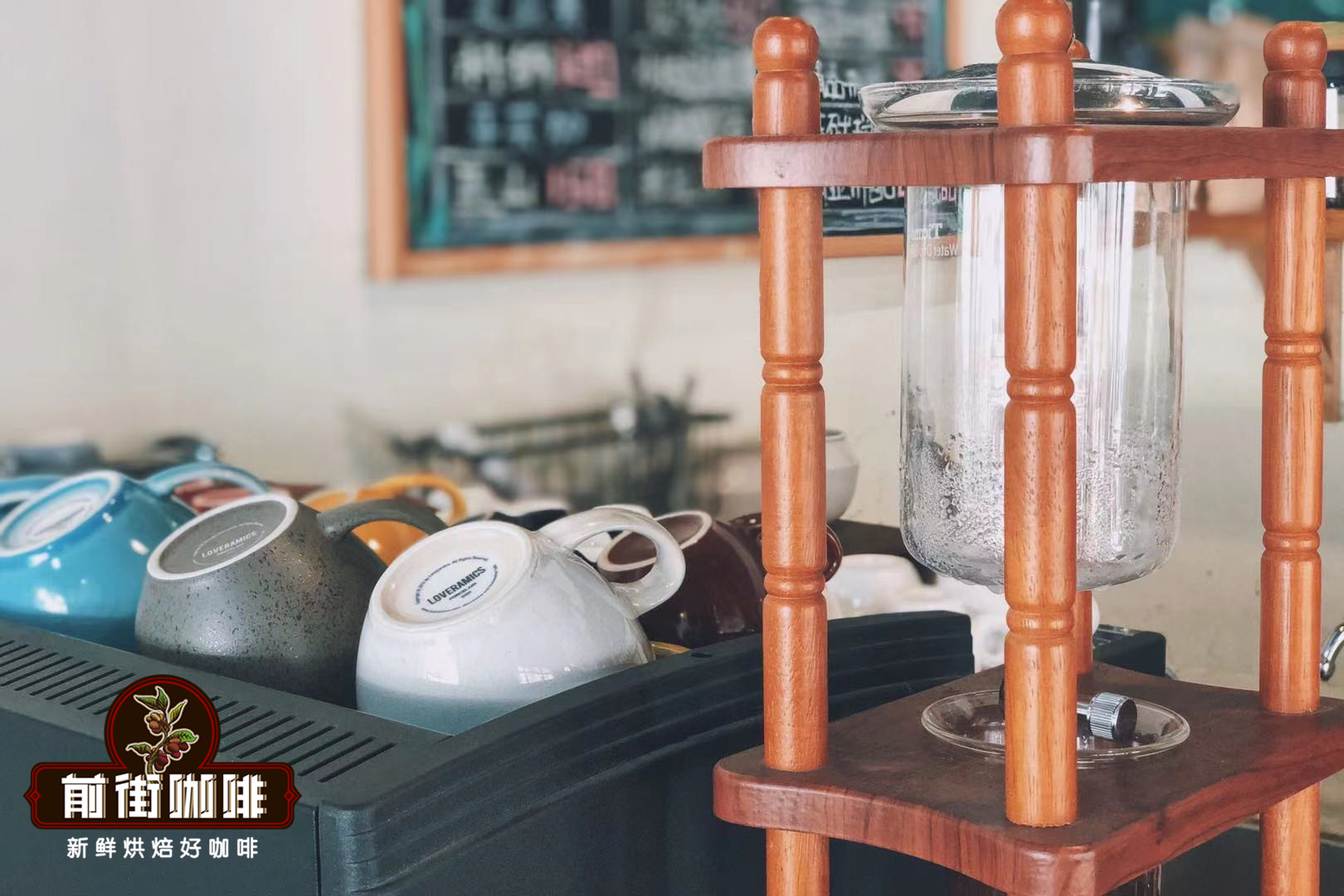
How to choose hand-brewed coffee beans? What is the ranking of boutique coffee brands? Friends who have just started coffee may first enter from the coffee brand list, thinking that the brand with high ranking must be good coffee. In fact, Qianjie Coffee believes that both single beans and Italian beans require fresh, individual beans look at the origin, altitude, treatment, Italian beans look at the blending formula. Coffee brand ranking is only a reference, not absolute, everyone's preferences are different, it is not that other people's NO.1 will be in line with your taste, does not mean that a high ranking is a good coffee brand, not a ranking is a bad coffee brand. We need to have this basic understanding before we know more about coffee. Qianjie believes that coffee beans have the flavor of producing areas, for example, the African coffee beans represented by Ethiopia will have the flavor of flowers and citrus, and the Asian coffee beans represented by Indonesia will have the flavor of herbs, nuts and woody spices. American coffee beans represented by Brazil have a balanced and chocolate flavor.
Because before this, the street association launched a series of rations and beans based on the flavor of the producing areas, including coffee beans from famous producing areas such as Ethiopia, Indonesia, Brazil, Colombia, Guatemala, Costa Rica and Yunnan, China.
Rations of beans do not mean bad, many people will have a misunderstanding that the low price of coffee beans must be poor quality. In fact, this is not accurate. Take clothes as an example. The same batch of clothes from the same garment factory will be sold for 50 yuan in the wholesale market and 500 yuan in the brand store. In essence, the quality of the two clothes is the same, but the price is ten times different.
The same is true in coffee beans. People are often proud of drinking high-quality coffee beans, which leads to a price discrimination. In the producing areas, beans are still the same beans, but at the end of the market, it is not surprising that the price is ten times different.

Qianjie has always believed that coffee beans should not be so expensive, and the original definition of boutique coffee is to distinguish former commodity beans and find better single-origin beans, which coincides with what Qianjie has to do.
The price of only 25 yuan / 100g rations beans can be traced back to the producing areas. For example, the Ethiopian rations beans in Qianjie come from the Yegashafi region, the Indonesian rations beans come from the Lindong producing areas, the Brazilian rations beans come from the Syrador producing areas, and the Colombian rations beans come from the Cymbidium producing areas. These producing areas are all famous ones. In fact, their prices are not as high as they are supposed to be.
Some people will say that even in the same producing area, there are high-quality coffee beans and low-quality coffee beans. If you sell them so cheaply, are they all bad coffee beans? Qianjie just wants to say that you don't know enough. Take Yega Xuefei coffee beans as an example, they are classified as G1-G5 according to the number of defects in raw beans, but in fact, when they come to the consumer market, they can only find G1 and G2, because other grades of coffee are sold domestically. The standard for G1 and G2 is only 8 defective beans / 300g. You know, this is in the state of raw beans.
Qianjie's standard before baking is the process of manually selecting seriously defective beans, that is to say, when it comes to cooked beans, the effect of raw beans on the flavor and quality of coffee can be ignored. Some smart guests understand this reason and will not hesitate to choose the food rations in front of the street.
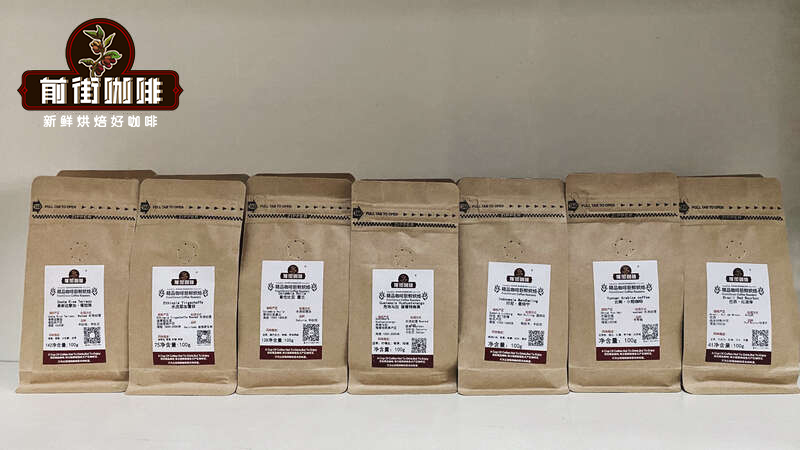
Suggestion on the data of hand-brewed coffee beans
The brewing data of Qianjie coffee: the weight of powder is 15g and the ratio of powder to water is 1:15. Except that these two data remain the same, the other parameters will change accordingly according to the degree of roasting of beans:
Baking degree
Shallow baking
Medium and deep baking
Use filter cup
V60
Kono
Water temperature
90 ℃
88 ℃
Grinding degree
The pass rate of No. 20 standard screen is 70-75%.
The pass rate of No. 20 standard screen is 80%.
Hand washing and cooking technique
Qianjie coffee chooses staged extraction, that is, three-stage water injection, steaming with 30 grams of water for 30 seconds, small water injection to 125 grams for stages, water level drop to 225 grams when the powder bed is about to be exposed, remove the filter cup when the water level drop is about to expose the powder bed, (steaming starts timing) the extraction time is 2 grams 3900 ".

V60 brewing
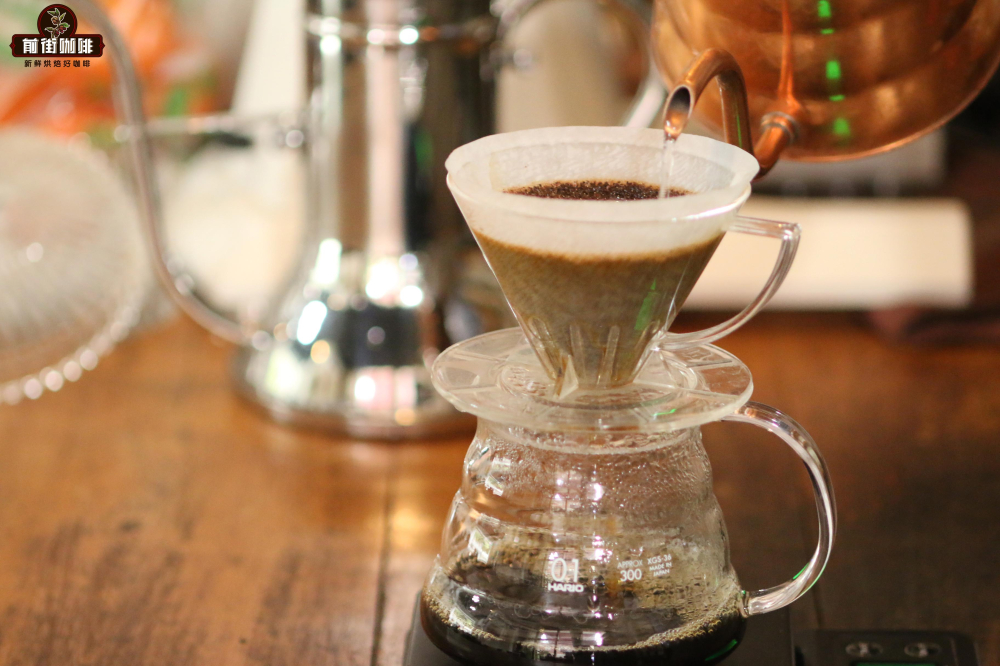
Kono cooking
A detailed explanation of the taste of the top ten coffee beans
1. Honduras Shirley Coffee beans, the Top Ten Coffee beans
Producing area
Massaguara City, Intibuka Province
Manor
Moca Manor
Altitude
1500-1700m
Variety
Kaddura, Kaduai, Pacas
Treatment method
Fine washed whisky Shirley barrel fermentation
Baking degree
Shallow baking
Flavor description: vanilla cream aroma, acidity of berries, rich dark chocolate almonds, smooth and stable taste.
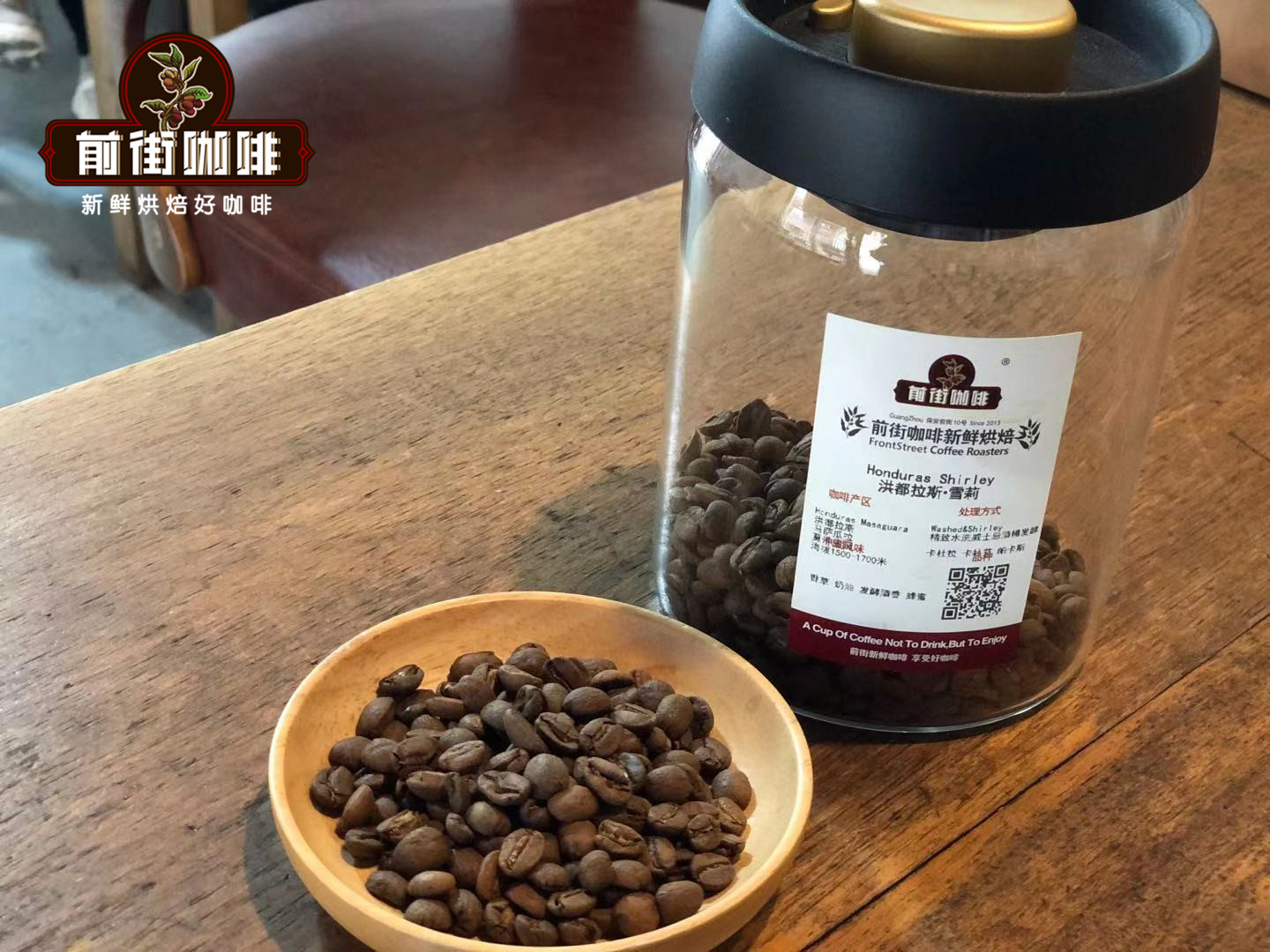
The coffee industry in Honduras has developed quite late, far less than most of the countries around Central America. With the full support of the government and drawing lessons from the development model of Brazil, the coffee industry in Honduras has gradually developed. In particular, in 2010, the involvement of Japanese boutique coffee made Honduras have the potential to become a superstar. Since 2011, Honduras has surpassed Guatemala in coffee production to become the largest coffee producer in Central America and one of the top 10 coffee producers in the world.
Most of the Honduran coffee is sold to Europe, and Germany is the main supplier of Honduran coffee, importing nearly 40 million kilograms of Honduran coffee every year. Although some Honduran coffee is sold to the United States and Japan, sales are not as impressive as in Europe.
There are 280000 hectares of coffee plantations in Honduras, mainly small coffee plantations, most of which are less than 3.5ha. These coffee plantations account for 60 per cent of all coffee production in Honduras.
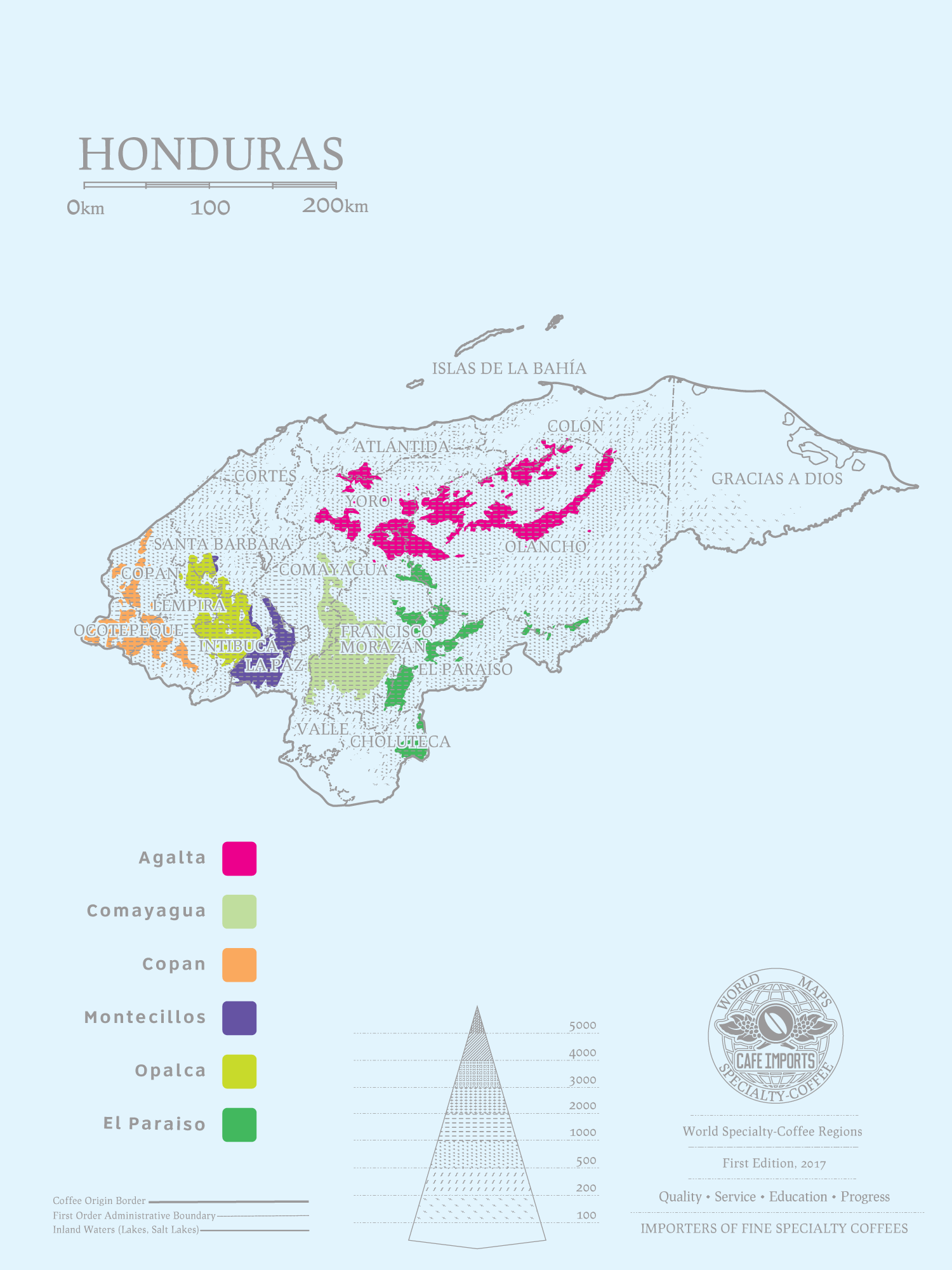
[production areas of Honduras]
Honduran coffee can be divided into six major producing areas, mainly located in the west and south of the Coban region (Copan), Obalaka region Opalaca), Mondesius (Montecillos), Gongma Agua (Comayagua), Agalta Tropical (Agalta Tropical), Parasso (El Paraiso). Among them, there are three major producing areas:
Montecius: the highest altitude producing area in Honduras, the coffee is bright and layered, full of rich fruit and sweet aromas, with citrus aromas.
Koban area: coffee beans in this area have chocolate flavor, mellow taste and high sweetness.
Akata: the coffee beans in this area have a sense of honey sweetness and acidity balance, and have chocolate tonality.
However, the recent hot sherry coffee beans and lychee orchid coffee beans are not from the above six producing areas, but from Masaguara, a city in Intibu á province in southwestern Honduras.
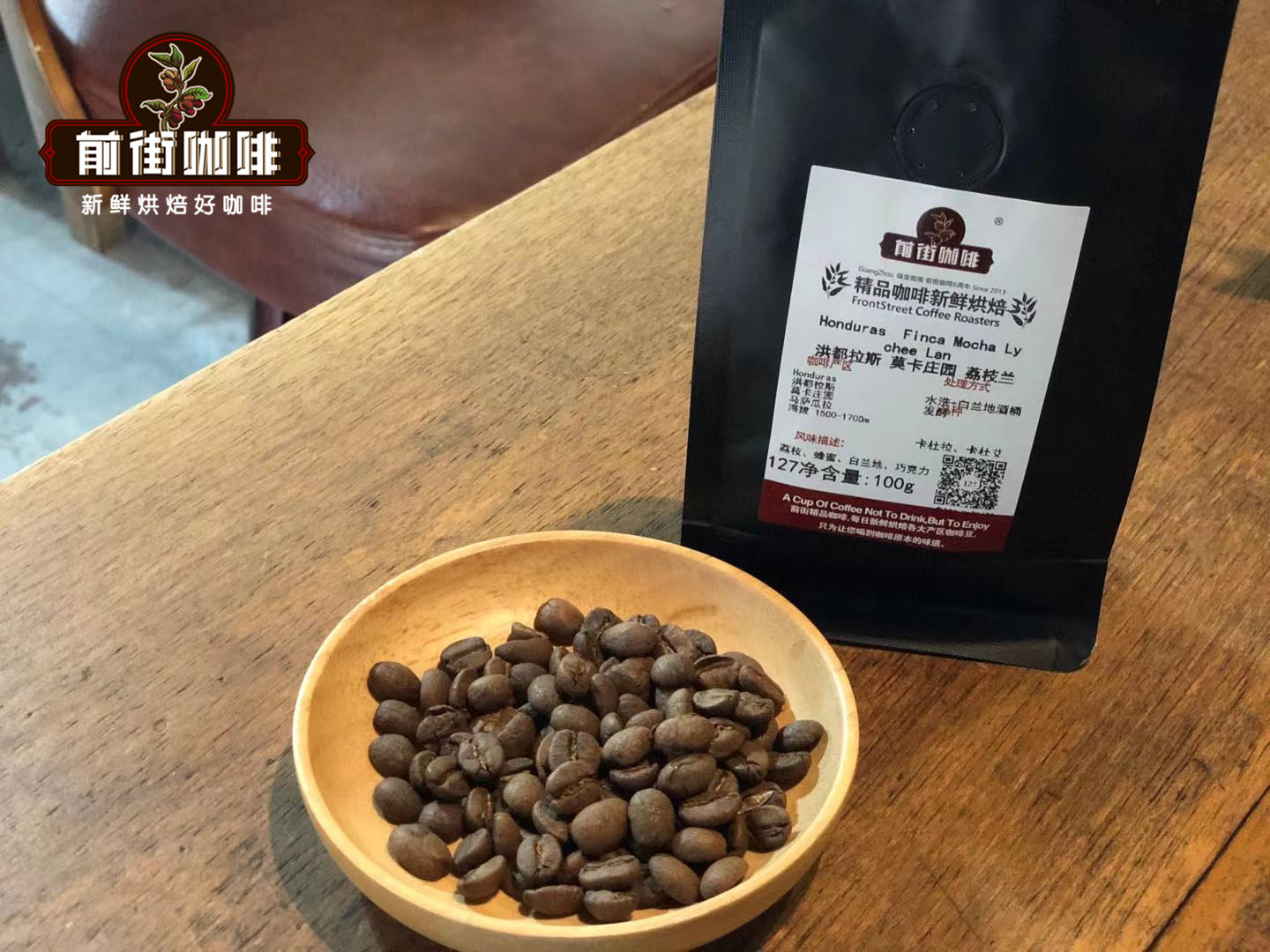
2. Ethiopia Sidamo Sakuran 5.0, the top ten coffee beans
Producing area
Sidamo Humbela
Altitude
2250-2350m
Variety
Primary species
Treatment method
Insolation
Baking degree
Shallow baking
Flavor description: obvious citrus, juice-like taste, slightly fermented, cool and refreshing, sugarcane-like sweetness, medium and high acidity.
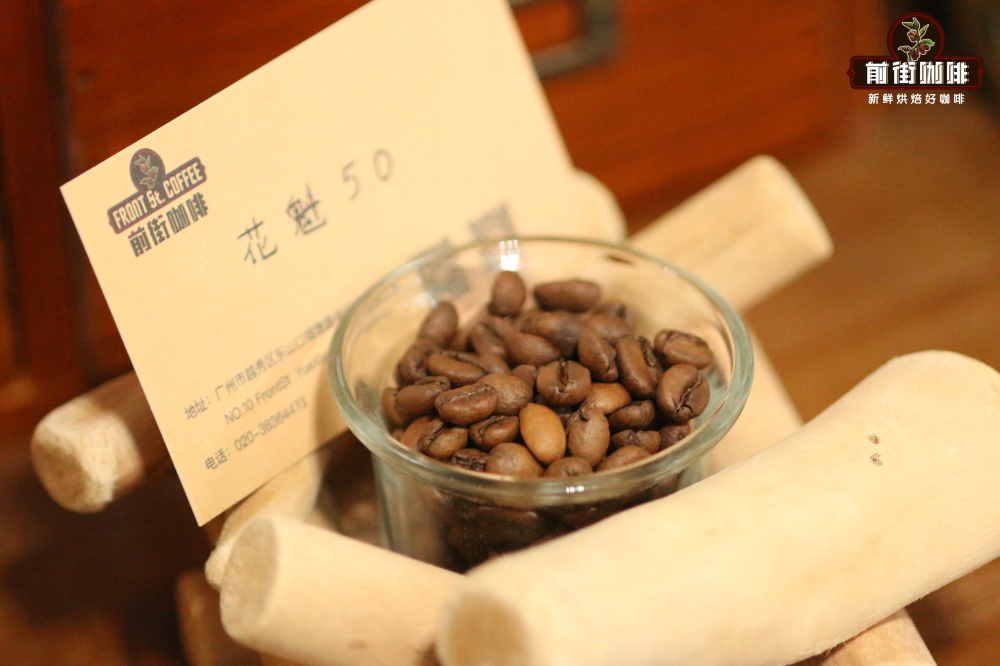
Ethiopia is currently the largest coffee producer in Africa, but only 60% of the beans are exported, while the rest are used in various forms of ceremony. for example, at weddings, coffee beans are mixed with coffee syrup, coffee and honey, and various herbs to ward off bad luck. Thus it can be seen that coffee is an inseparable part of local life.
Since Ethiopia changed the administrative division around 1995, the greatest impact on the coffee area is that the original Sidamo Sidamo province is divided into the new Sidamo Sidama (the original minority), and most of it is classified into the Oromia Oromia state. And Yega Xuefei, which used to belong to Sidamo province, is now included in the new Gedeo of Gaidio, and there will be a mix of Ethiopian coffee products in circulation in the market named after the new and old regions.
Ethiopia's coffee cultivation is mainly in the western and southern region, and small farmers account for 90% of the total. Nearly 1.2 million of small farmers make a living by growing coffee, with an average planting area of less than 4 hectares, an average altitude of 1000-2300 meters, a planting density of 1000-1800 coffee trees per hectare, and a yield of nearly 600kg per hectare.
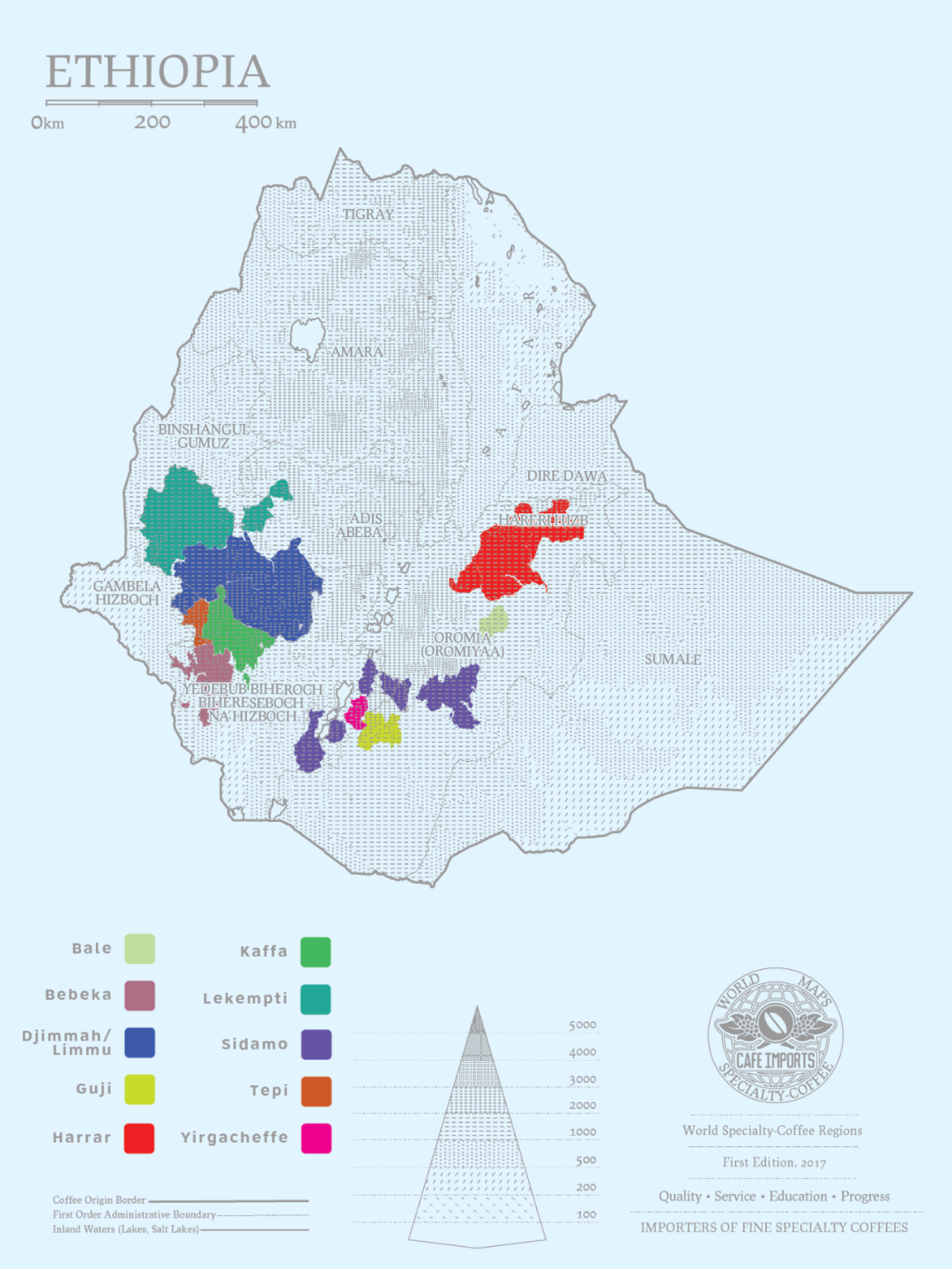
Ethiopia's Nine Coffee Producing Areas
① Yejia Xuefei (fine production area): altitude 1,800 ~ 2,000 meters (pastoral coffee system)
② Sidama (fine production area): altitude 1,400 ~ 2,200 meters (pastoral coffee system)
③ Lim (fine production area): altitude 1,200 ~2000 meters (pastoral, forest, semi-forest, plantation coffee system)
④ Hara (fine production area): altitude 1,500 ~2400 meters (pastoral coffee system)
③ Jinma (commercial soybean production area): altitude 1,350 ~ 1,850 meters (forest/semi-forest system)
① Iruba (bulk commercial bean production area): altitude 1,350 ~ 1,850 (forest/semi-forest coffee system)
③ Kimbi, Lekati (commercial bean production area): altitude 1,500~1,800 (forest/semi-forest coffee system)
Tiebi, Beibeika (bulk commercial bean production area): 500~ 1,900 meters above sea level (pastoral/forest/semi-forest coffee system)
Lake Tana (alternative production area): elevation 1,840 meters (forest system)
3. Mozart of the Costa Rican Musicians Series of the Top Ten Coffee Beans
producing areas
Tarazhu
Manor
Carnet Manor
altitude
1980m
varieties
Kadulla, Kaduai
approach
raisin honey treatment
roasting degree
light baking
Flavor Description: Intense floral and fermented sauce aromas, rich berry, raisin sweetness, soft acidity, sweet tropical fruit aromas, sweet cane.
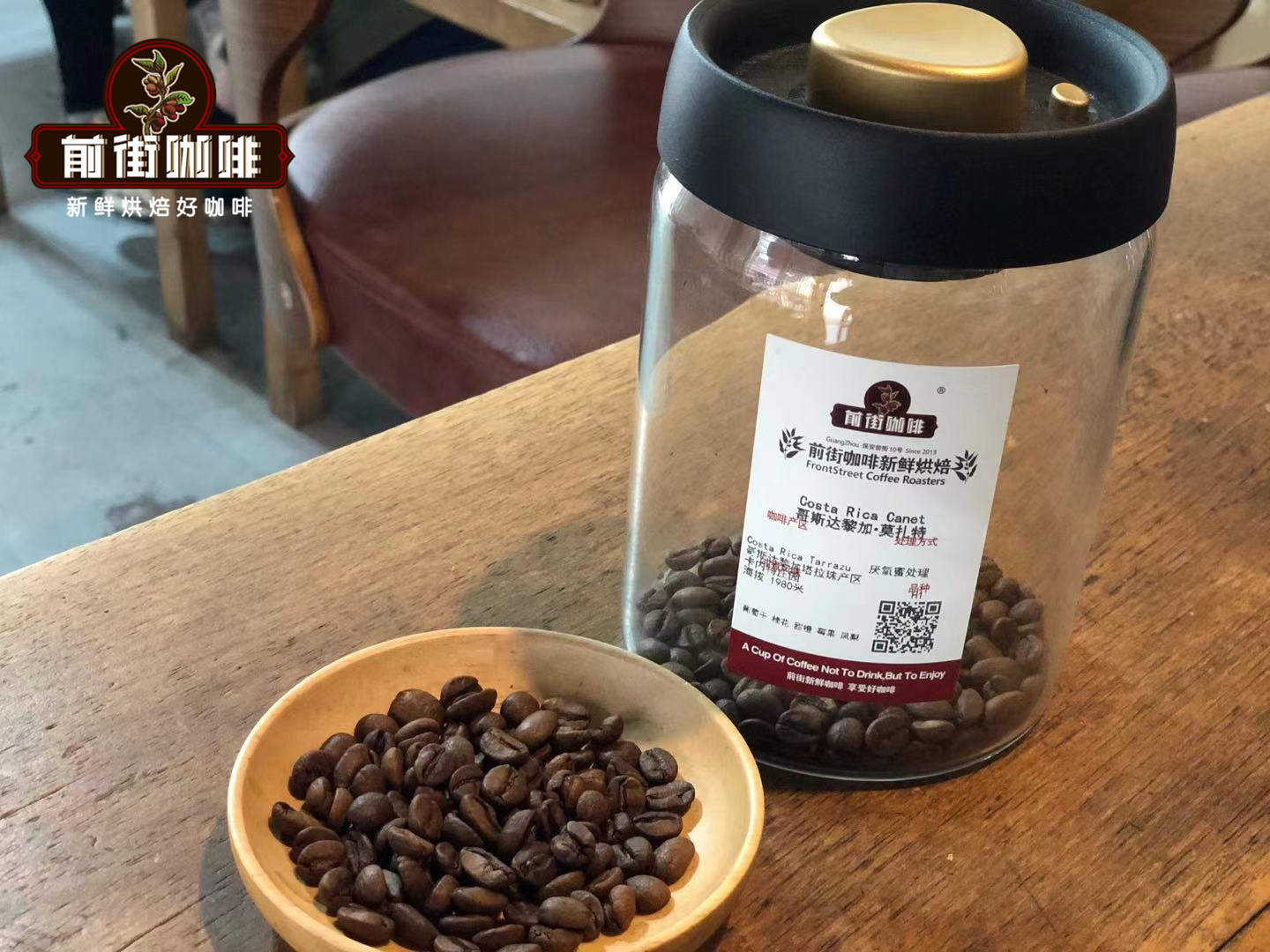
The coffee industry in Costa Rica started early and was the first to grow coffee in Central America. Coffee was transported to Europe in 1820 and became popular in an instant, and it was once known as the "golden bean" by British aristocrats. After that, Costa Rica was freed from Spanish colonial rule, and the local government began to vigorously support the coffee industry with a series of policies, promoting the development of private estates. Increasingly wealthy coffee farmers sent their children to Europe for further study. Cheng Cheng returned to work as a doctor and engineer. Thus it can be seen that coffee farmers have a high status in Costa Rica. In addition, Costa Rica has a law that only allows the planting of Arabica coffee beans. Robusta coffee beans are "contraband" in Costa Rica, which is the only initiative in the world.
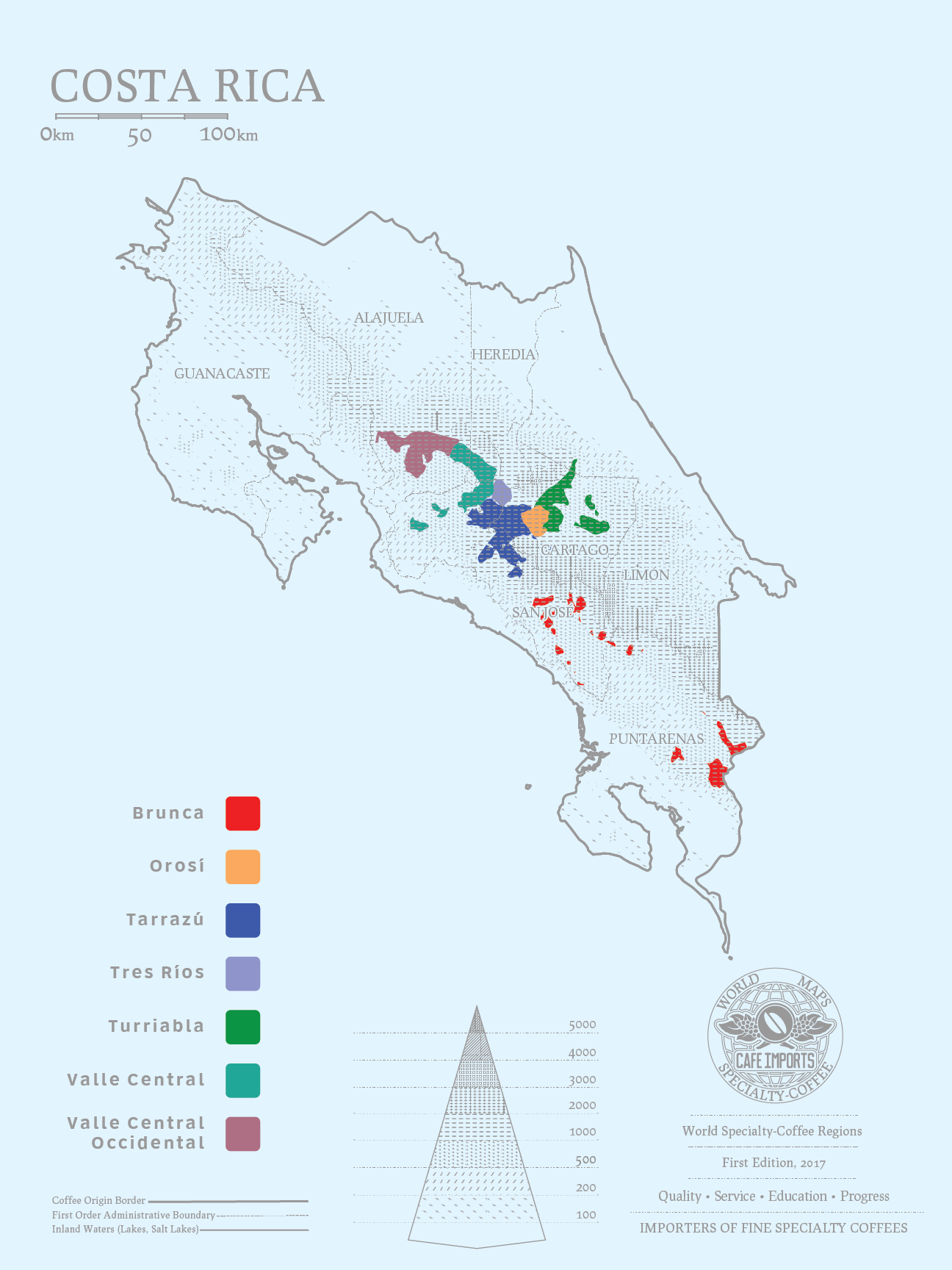
[Costa Rica producing area]
Costa Rica mainly has eight major coffee producing areas: West Valley in the western valley, Central Valley in the central valley, Tarrazu in Tarasu, Tres Rios in the Sanshui River, Orosi in Europe, Brunca in Brenka, Duli Alba Turrialba and Guanacaste in Guanacaster. Among them, the Central Valley, Tarazhu and Sanhe producing areas are the most famous.
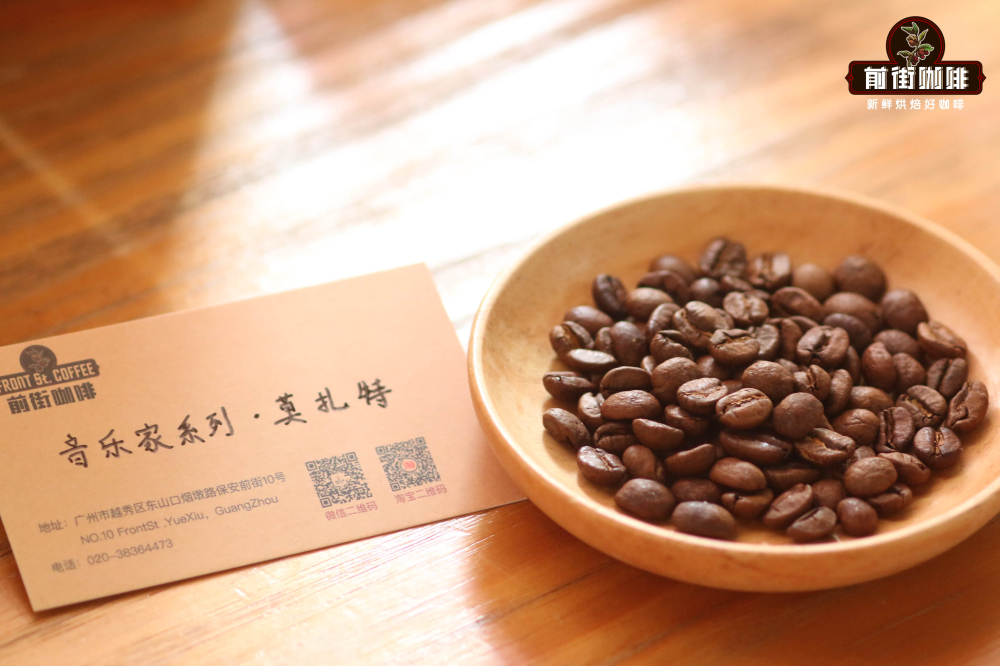
4. Indonesian gold Manning, the top ten coffee beans
Producing area
Sumatra
Company
PWN
Altitude
1100-1600m
Variety
Iron pickup
Treatment method
Wet planing method
Baking degree
Medium and deep baking
Flavor description: mellow and clean, high sense of balance, strong nutty, chocolate flavor, strong spice and caramel aroma, with fruity aromas and a long finish.
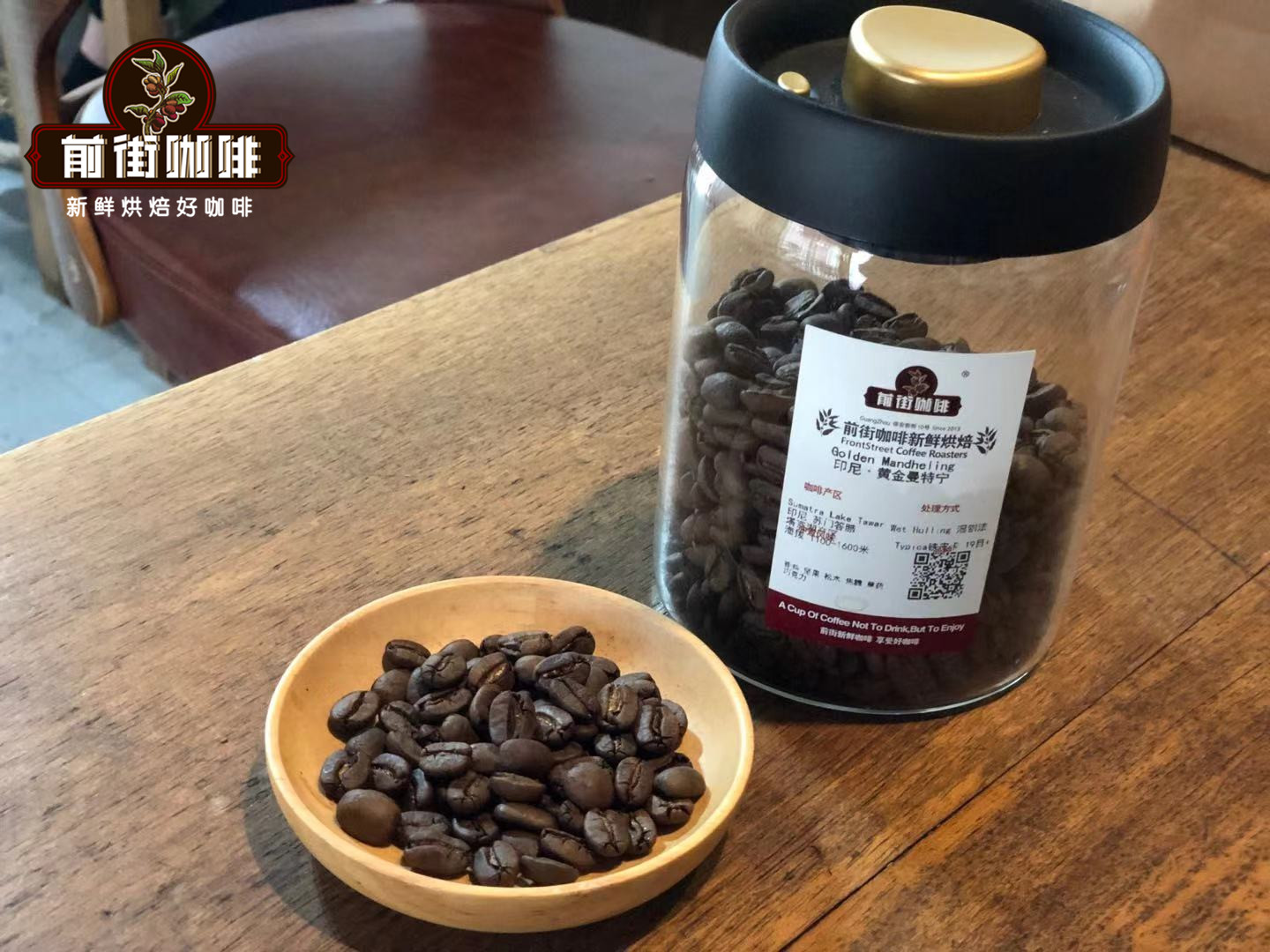
Indonesia Indonesia is located in southeastern Asia. In 1696, in order to expand the coffee growing base, the Dutch found Indonesia and first introduced coffee beans to the country's Java island to grow coffee beans in large quantities. However, in 1877, leaf rust swept through almost all coffee trees in Indonesia, and Arabica coffee beans were almost wiped out, causing heavy losses.
Later, Indonesia introduced robusta coffee beans from Africa. Robusta coffee beans have strong disease resistance, which makes up for the economic losses caused by the disease resistance of Arabica coffee beans. Indonesia is now the main producer of robusta coffee beans in the world. Robusta coffee beans are grown in southern Sumatra, Indonesia, while Arabica coffee beans are grown in northern Sumatra, Indonesia. Although Arabica coffee beans account for only about 10% of the total coffee beans in Indonesia, they are enough to attract the attention of the world, including Manning coffee as we all know.
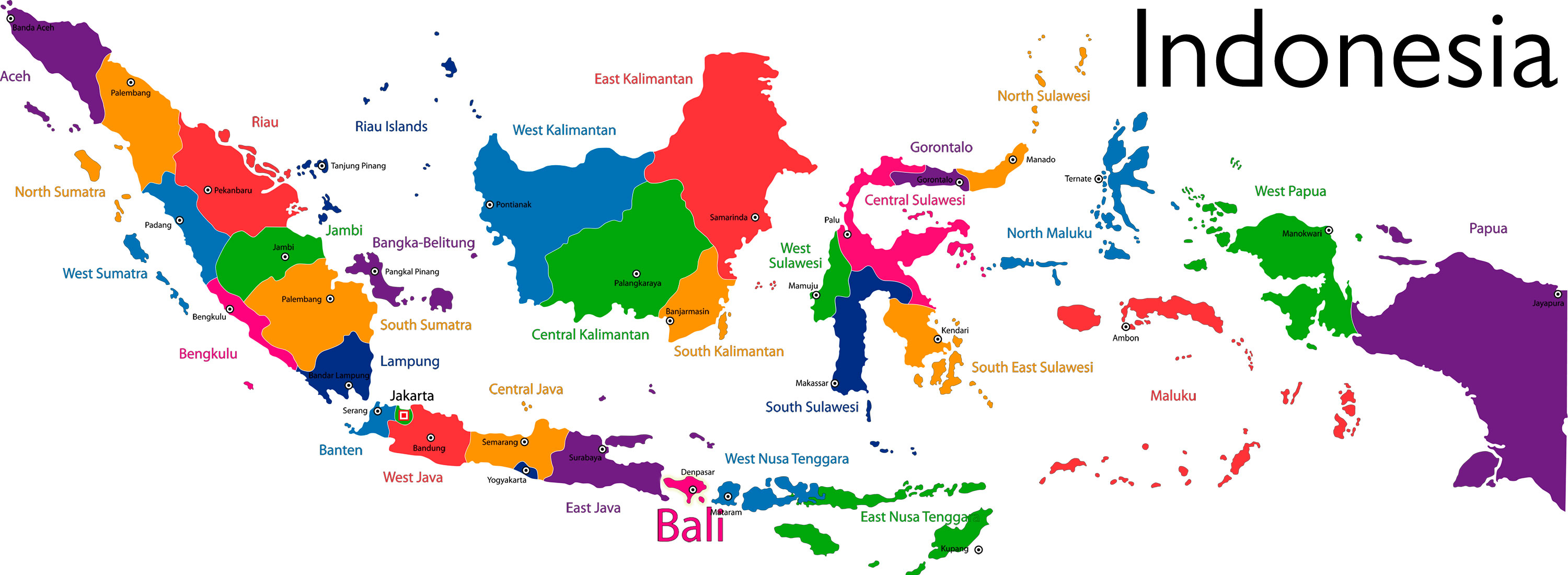
The main treatment methods of Indonesian coffee beans are sun treatment, water washing and wet planing. Because of the humid climate, Rain Water frequently, in order to pursue a more efficient drying, the use of water washing treatment and wet planing method.
The most famous coffee bean treatment in Indonesia is the wet planing method. The area where this treatment is used is mainly distributed in Sumatra in western Indonesia, which is rich in rich Mantenin coffee. The wet planing method mainly has two stages: peeling off the peel and pulp of the coffee fruit, briefly fermenting and drying until the moisture content is reduced to 12-13%. This rapid treatment can cause coffee beans to be squeezed and cracked, which is what we call sheep's hoof beans, which is a characteristic of Mantenin coffee beans, not a flaw.
In addition to the conventional wet planing, there is also an old wet planing method. Coffee beans are first treated by ordinary wet planing, and then sealed in the warehouse for 2-3 years. During this period, the acidity of the coffee beans will slowly weaken and turn into sugar, and the Mantenin coffee beans treated with this method are also called old Mantenin coffee beans.
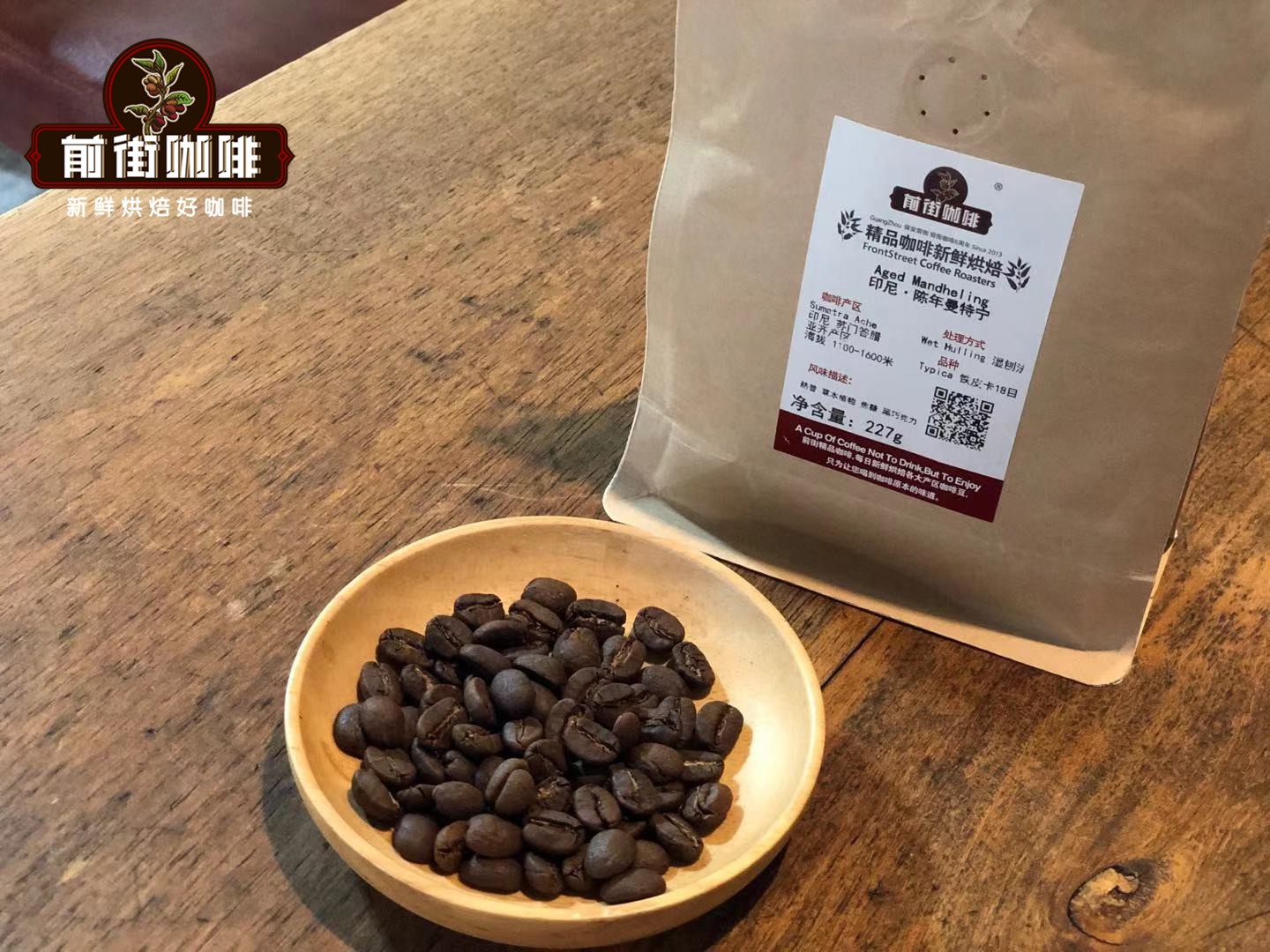
5. Top Ten Coffee beans: Panamanian Jade Manor Red Standard Rose Summer
Producing area
Pocket.
Manor
Jadeite Manor
Altitude
1700m
Variety
Rose summer
Treatment method
Insolation
Baking degree
Shallow baking
Flavor description: there are ginger, citrus aromas, the entrance has ripe fruit, black tea, sweet and sour fruit tea flavor, the aftertaste has the sweet feeling of berries, Huigan is more lasting.
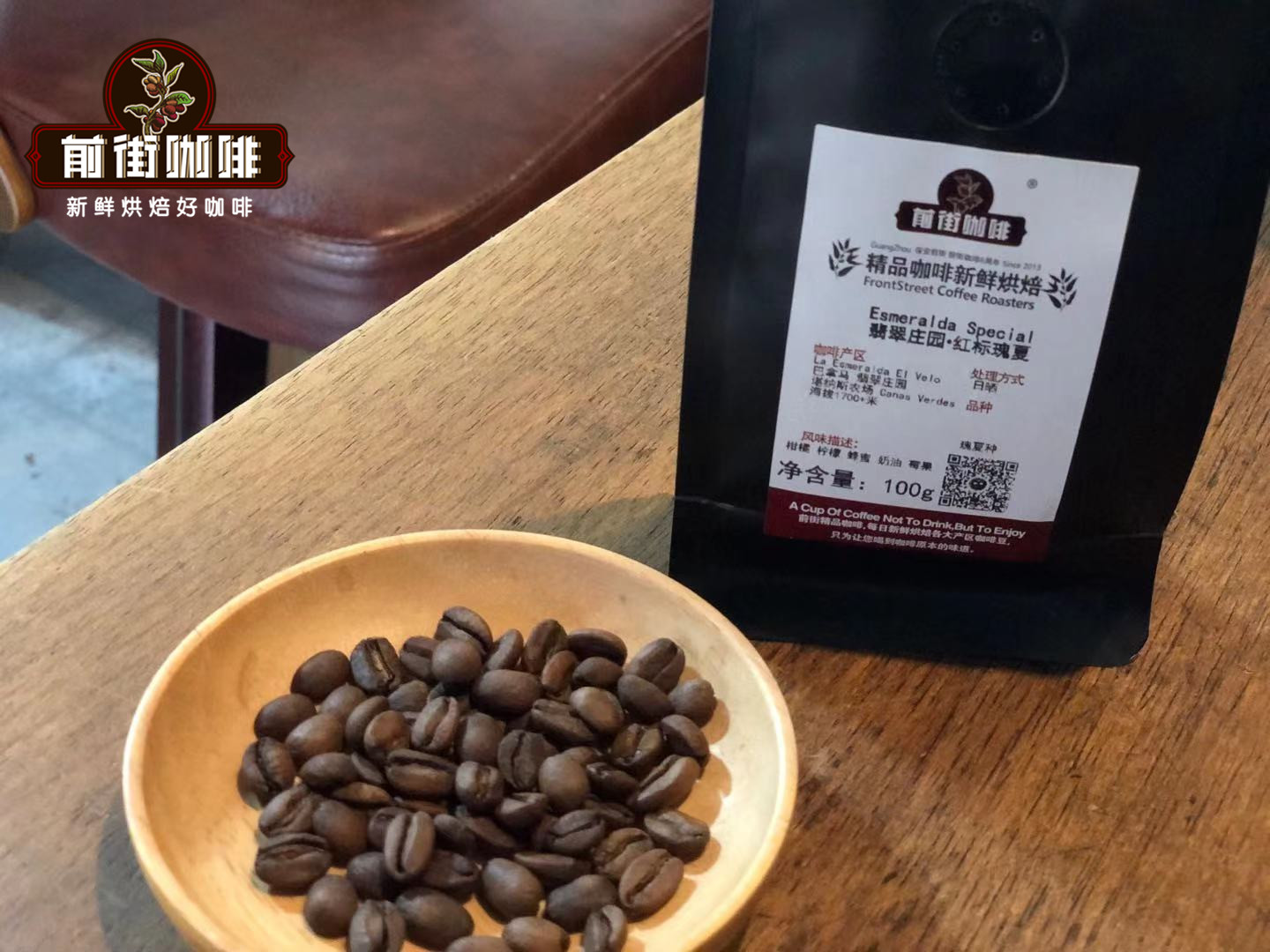
Panamanian caffeine is famous all over the world, which is closely related to Panama's unique physical and geographical conditions and fine management model. Panama has volcanic ash soil, sufficient air humidity and abundant solar energy resources. After Panama opened the canal at the end of the 20th century, many American elites went south, on the one hand, to demand jobs, and on the other hand, to tap business opportunities. At this time, coffee developed by leaps and bounds, which established Panama's position in boutique coffee.
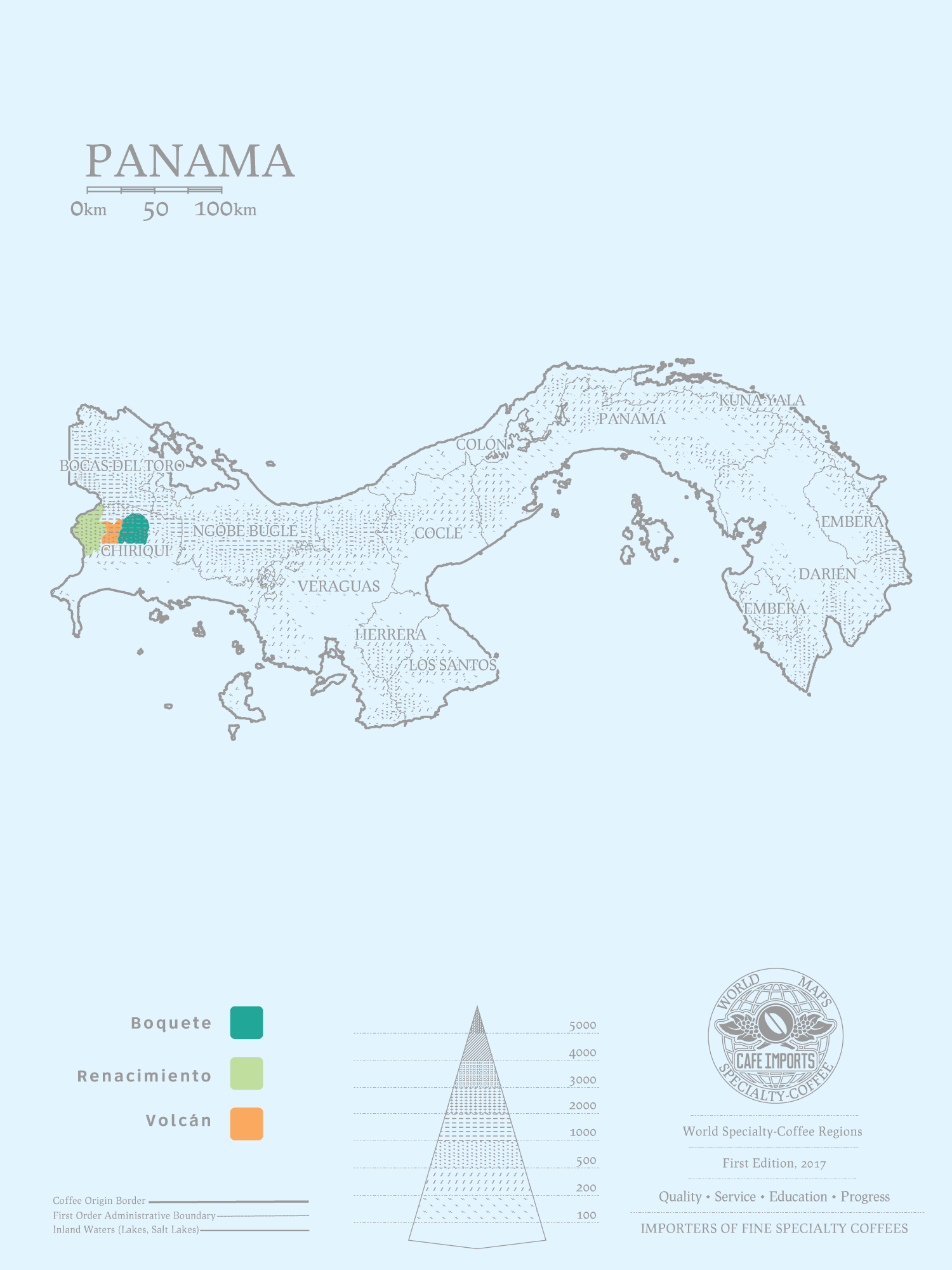
[Panamanian producing area]
There are four main coffee producing areas in Panama: Poquet Boquete, Walken Volcan, Santa Clara Santa Clara, Kendra Piedra de Candela.
Pokuit, with an average elevation of 1450 meters, produces the most coffee and the best quality coffee in Panama, such as Emerald Manor, Arida Manor, Catova Manor and so on.
Walken producing area, with an average elevation of 2000 meters, has a mild and balanced coffee feature.
Santa Clara producing area, with an average elevation of 1500 meters, near the Panama Canal, is very convenient for transporting coffee.
The Kendra producing area, with an average elevation of 1200 meters, has attracted more and more attention in recent years, and the industry believes that it has the potential to develop high-quality stunt coffee.
Panama is famous for growing rose summer, and rose summer is also famous for Bole, the Emerald Manor. The best non-auction rose summer of the Jadeite Manor is the red mark series, which is officially called "Jadeite Special selection" in Chinese. The name of the red mark is because the promotional picture of this series is based on red.
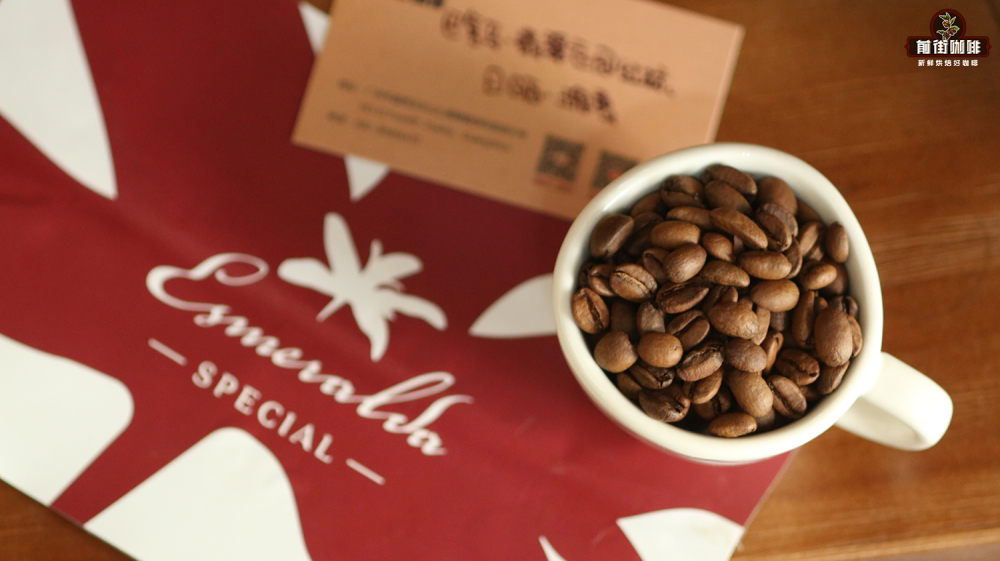
Columbia Rose Valley, the Top Ten Coffee beans
Producing area
Santander
Manor
Dashu Manor
Altitude
1700m
Variety
Kaddura
Treatment method
Anaerobic double enzyme washing
Baking degree
Shallow baking
Flavor description: rich rose flowers, sugarcane-like sweetness, strawberries, grapes and fruits with outstanding acidity and sweetness.
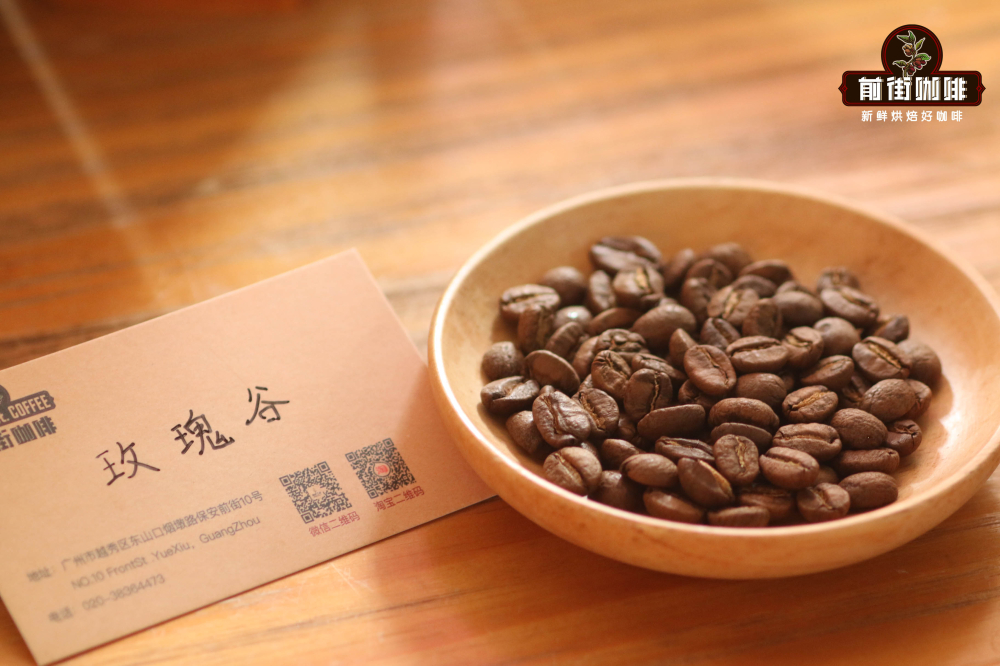
Colombia is the third largest coffee producer in the world, located in northwestern South America, and the climate varies according to the topography. The southern part of the eastern plain and the Pacific coast have a tropical rain forest climate, the mountains with an elevation of 1000-2000 meters have a subtropical climate, and the northwest has a savanna climate. Colombian coffee is not as mellow as Brazilian coffee, and its acidity is not as bright as African coffee, with a good sense of balance, nutty and sour fruit.
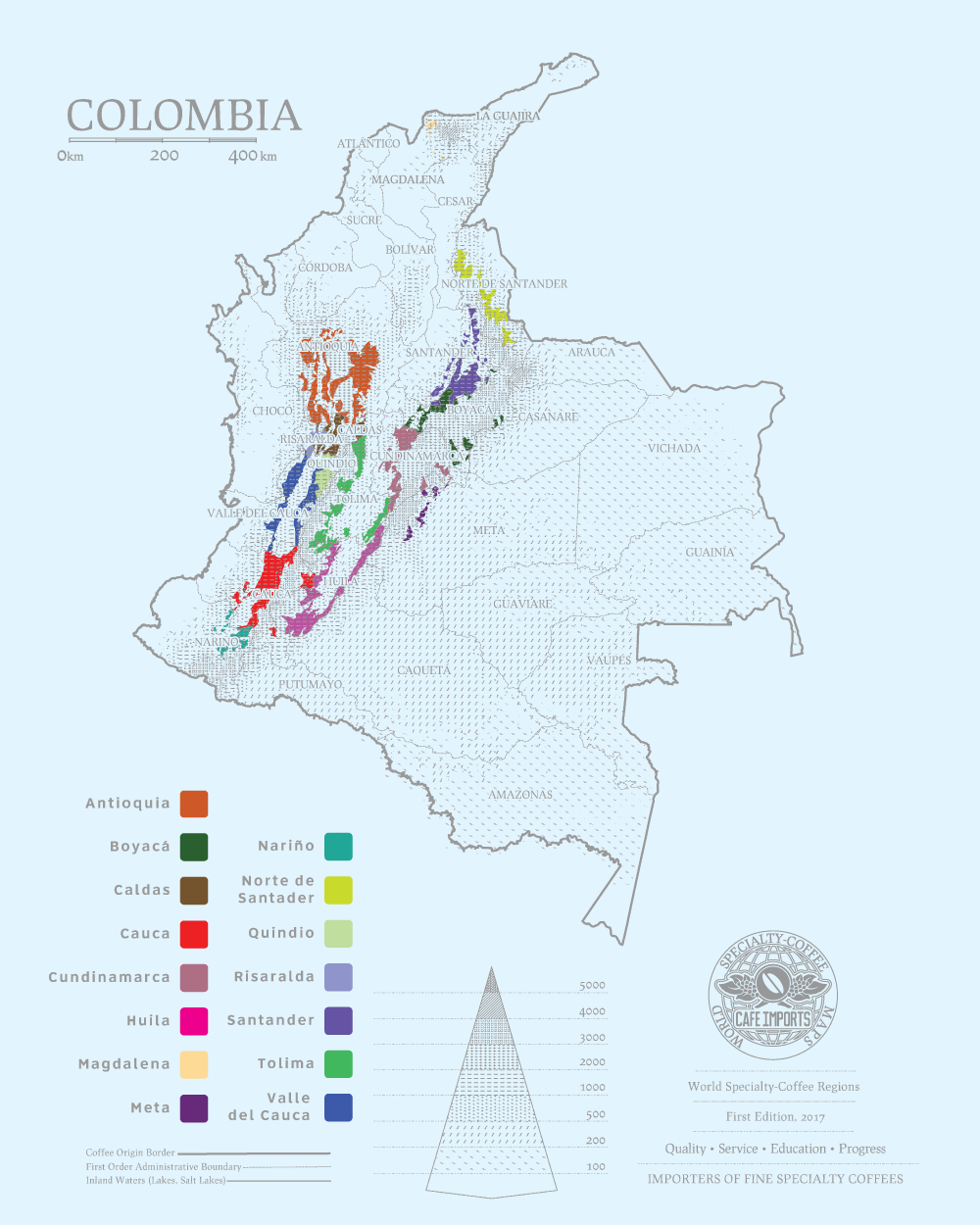
[Colombian producing area]
Columbus coffee cultivation is distributed along the Andes Mountains. From south to north, the coffee producing area is divided into four major producing areas: the north, the central, the south and the east.
Northern coffee producing areas: there is only one dry season (December to March) and one rainy season (April to November) each year. Coffee blossoms in March, followed by the rainy season and harvested in October and November. The coffee producing areas in the north are subdivided into micro-producing areas such as Santander, North Santander, LaGuahira, Magdalena and Cesar.
Central coffee producing area: there are two dry seasons and two rainy seasons every year, the dry season is from December to February and June to September, and the rainy season is from March to May and September to November, which leads to two coffee harvest seasons every year. Micro-production areas include southern Antioquia, Boyaca, Caldas, Choco, Risalda, Jindio, northern Cauca Valley, Cundinamaka and northern Tolima.
Eastern coffee producing areas: coffee cultivation is much smaller and the climate is similar to that of the north, but the rainfall and humidity are higher than those of the north. It only includes production areas such as Arauca,Casanare,Meta and Caqueta. The eastern producing areas have suffered from armed conflicts in the past and are in urgent need of coffee production to drive economic recovery. The National Coffee producers Association of Colombia is investing in helping the region grow varieties that better suit its environment, and they are also focused on helping farmers expand the size of their farms.
Southern coffee producing areas: near the equator, coffee grows in higher mountains. Like the north, there is only one wet season and one dry season in the south. The dry season is from June to September, and the rainy season comes in October and may last until May of the following year. In contrast to the north, coffee is harvested in autumn in the north, while the harvest season in the south usually begins in April and lasts until June, and raw bean merchants can supply Colombian coffee beans to customers almost all year round. In the south, there are mainly boutique coffee varieties, including Hulia in Huilan province, Cauca in Cauca province, Narino in Nari ñ o province and Tolima in Tolima province.
7. Jamaica Blue Mountain of the Top Ten Coffee beans
Farm
Clifton Farm
Altitude
1310m
Variety
Iron pickup
Treatment method
Water washing
Baking degree
Medium baking
Flavor description: sweet, sour, bitter balance, bright and delicate acidity, citric acid tone, sweet chocolate, cocoa aftertaste, clean, full-bodied and smooth taste.

Jamaica is an island in the Caribbean. Jamaica's Blue Mountains are the highest in the Western Caribbean (2256m above sea level, only below 1700m can stop coffee, above is a protected forest). Blue Mountain is located in the coffee belt of 25 degrees north latitude, with fertile volcanic soil, fresh air, year-round rain, high humidity, large temperature difference between day and night, regular rainfall and under the hazy clouds on the island, keep the coffee trees away from the hot sun.
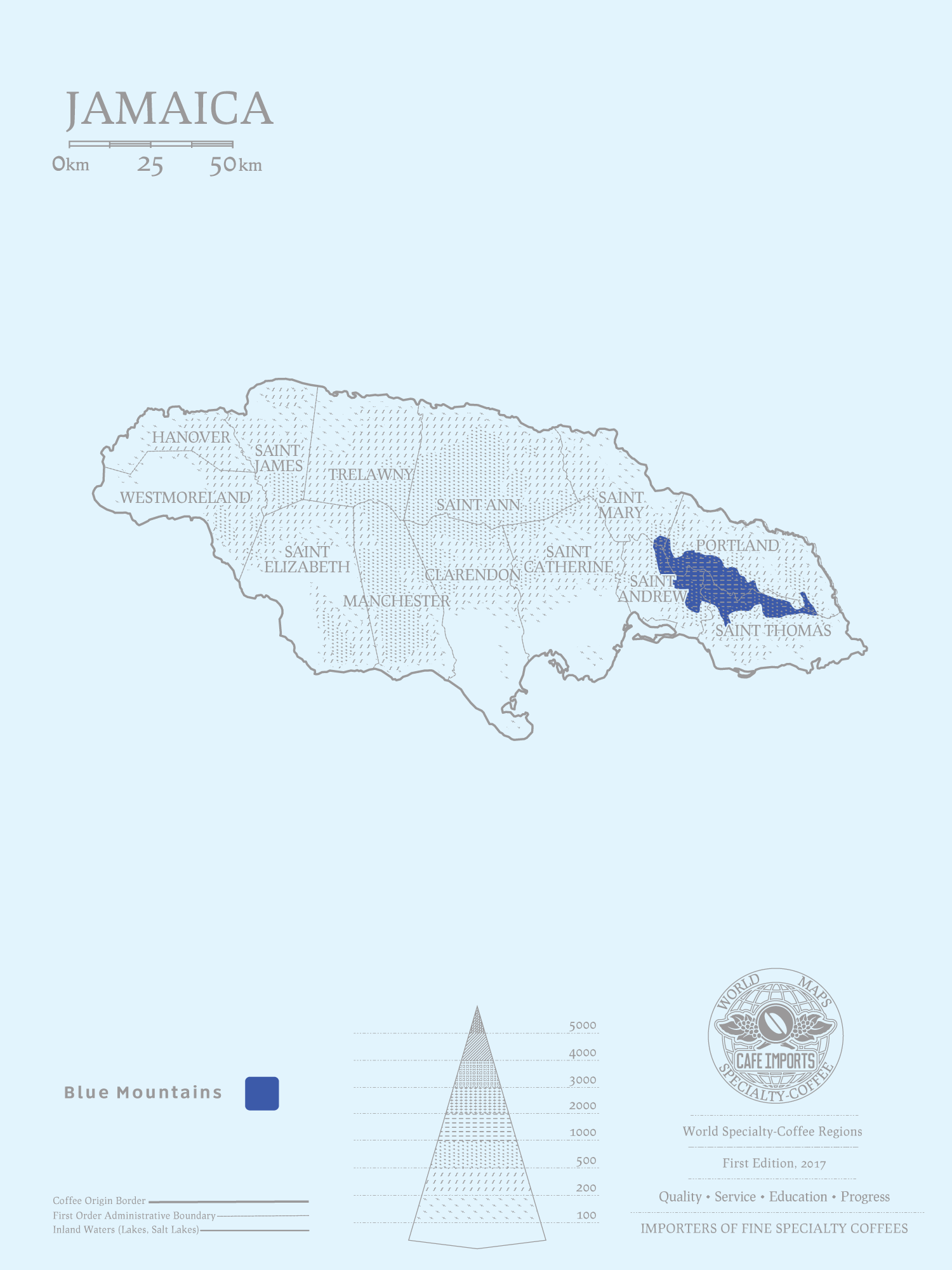
[Jamaica Blue Mountain Coffee Bean grading]
There are three grades of coffee in the Blue Mountains of Jamaica: blue Mountain Coffee (Blue Mountain Coffee), Alpine Coffee (Jamaica High Mountasin Supreme Coffee Beans) and Jamaican Coffee (Jamaica Prime Coffee Beans).
There are grades under the Blue Mountain Coffee. From high to low is: blue Mountain No. 1, Blue Mountain No. 2, Blue Mountain No. 3, PB (also known as public beans, round beans).
Blue Mountain No. 1 (No.1): 96% of raw beans are 17x18-mesh beans, with a defect rate of less than 2%.
Blue Mountain No.2 (No.2): 96% of raw beans are 16x17-mesh beans, with a defect rate of less than 2%.
Blue Mountain No. 3 (No.3): 96% of raw beans are beans with 15 grams and 16 mesh, with a defect rate of less than 2%.
PB:96% raw beans are PB, and the defect rate is less than 2%.
8. Asalia, Kenya
Producing area
Sika
Treatment plant
Asali Honey processing Plant
Altitude
1550-1750m
Variety
SL28,SL34
Treatment method
Kenya 72-hour washing
Baking degree
Shallow baking
Flavor description: ripe tomato and floral aromas, imported virgin fruit and black plum flavor, bright acidity, clean and rich taste, finish raspberry and yellow sugar sweet, and have green tea aroma.
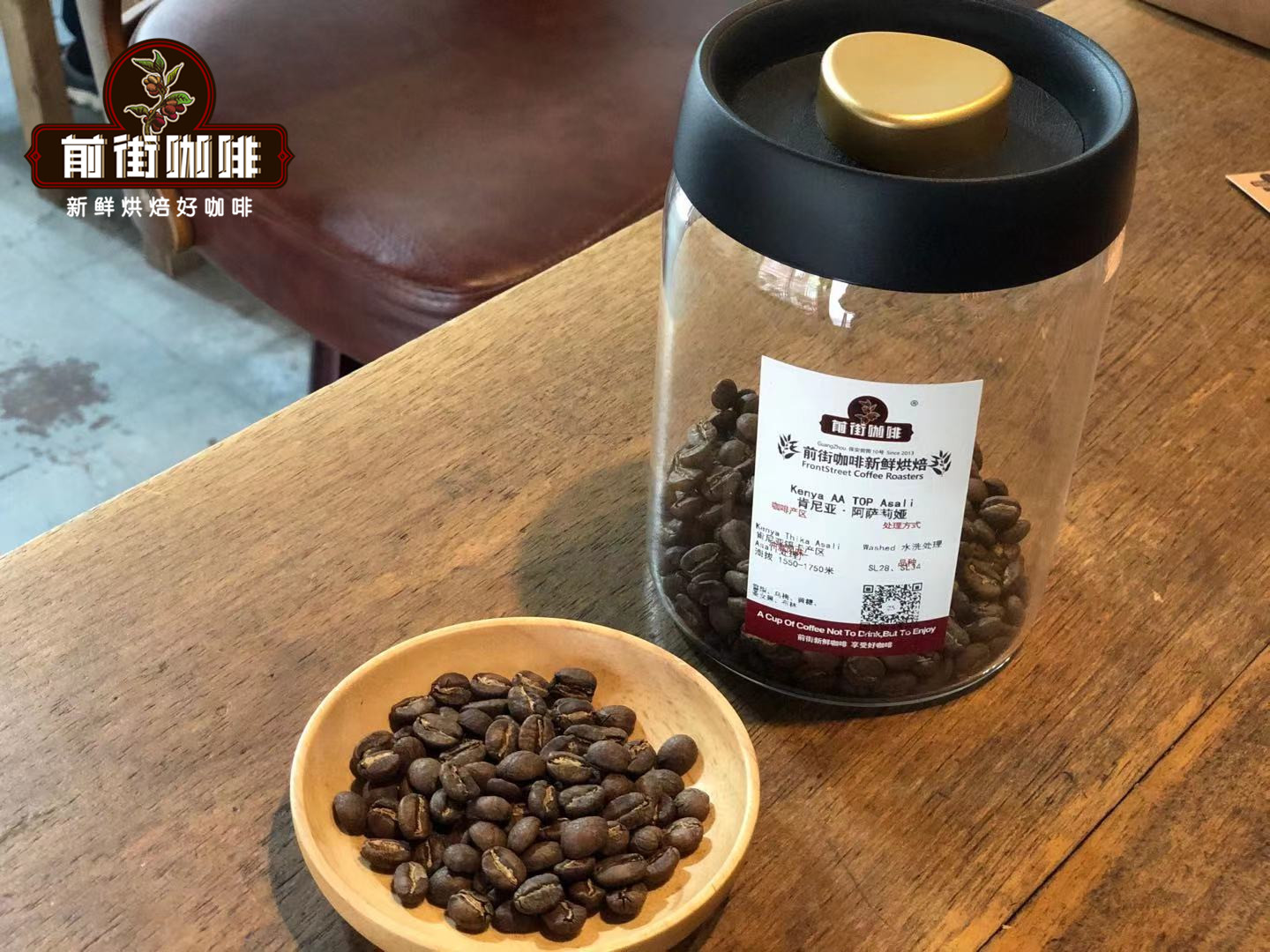
Kenya is located in eastern Africa and borders Ethiopia, the birthplace of coffee. It was not until near the 20th century that Kenya introduced coffee, during which coffee almost circled the world before returning to Africa. But Qianjie Coffee believes that although Kenyan coffee started late, it developed rapidly. Under British colonial rule, whether it was the establishment of the cultivation mechanism or the establishment of a grading system, Kenyan coffee beans all led to the boutique coffee market.
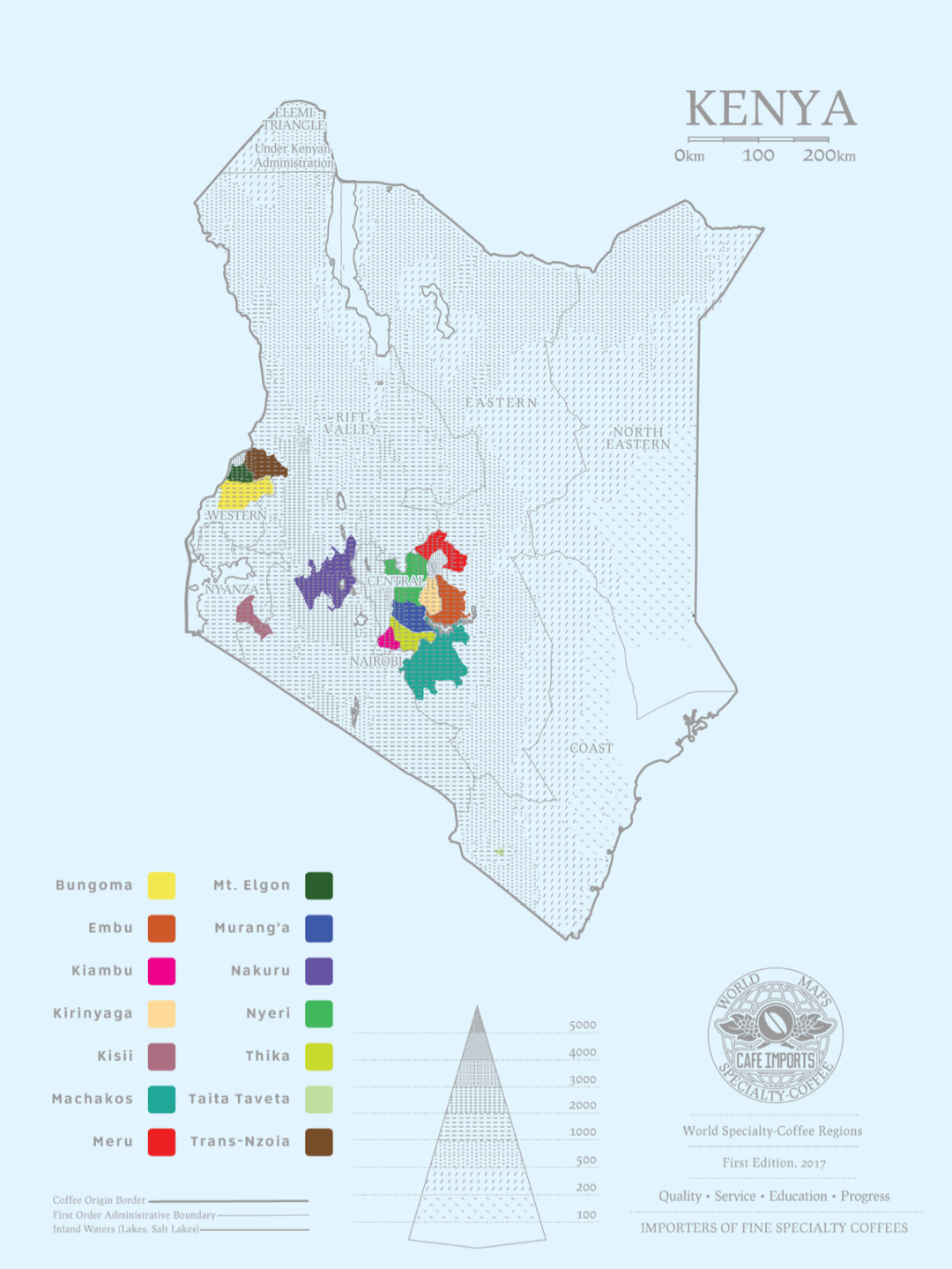
Kenyan boutique coffee is now known around the world, and Front Street Coffee summarizes the following reasons:
1. Establishment of cultivation mechanism. In 1883, Britain brought coffee to Kenya from Reunion Island. In 1922, Scott Labs (SL28 SL34) was established in Kenya to engage in coffee cultivation research. Within more than 10 years after its establishment, the laboratory selected SL28 and SL34 from 42 kinds of coffee, which provided a good start for the development of coffee industry.
2. The government attaches importance to it. In 1931, the Kenya Growers Cooperative Union and the Kenya National Coffee Council were established to guide the development of the coffee industry at the private and national levels. In 1937, the Nairobi Coffee Exchange was established, which started the auction system for Kenyan coffee, and good coffee had a good price, setting the tone for coffee prices. In particular, this year Kenya's Ministry of Agriculture launched a 1.5 billion shilling coffee revitalization programme.
3. Determination of classification system. Kenya is graded according to bean size and cup test results. According to the size, shape and hardness of coffee beans, from high to low AA or AA+, AB, PB, C, E, TT, T. For AA and AB grade coffee beans, a special classification of cup test results (not officially recognized by Kenya, formulated by exporters) has been added, which is TOP, PLUS (+) and FAQ from high to low.
4. K72 treatment. The characteristic acidity of Kenyan fine coffee has a lot to do with its excellent processing. Generally, the washing method selects coffee fruits with high maturity, removes the peel and pulp, and steeps the fermentation tank to remove pectin. This process rarely exceeds 36 hours, but the fermentation time in Kenya is as long as 72 hours. Then dry it until the moisture content reaches 12%.
9. Brazilian Queen Manor
producing areas
Morgiana
Manor
Queen's Manor
altitude
1400-1950m
varieties
yellow bourbon
approach
half sun
roasting degree
Zhongbake
Flavor Description: Intense nutty, dark chocolate flavors, fermented fruit, with a distinct sweetness, with a hint of lemon aroma, the overall feeling is relatively round.
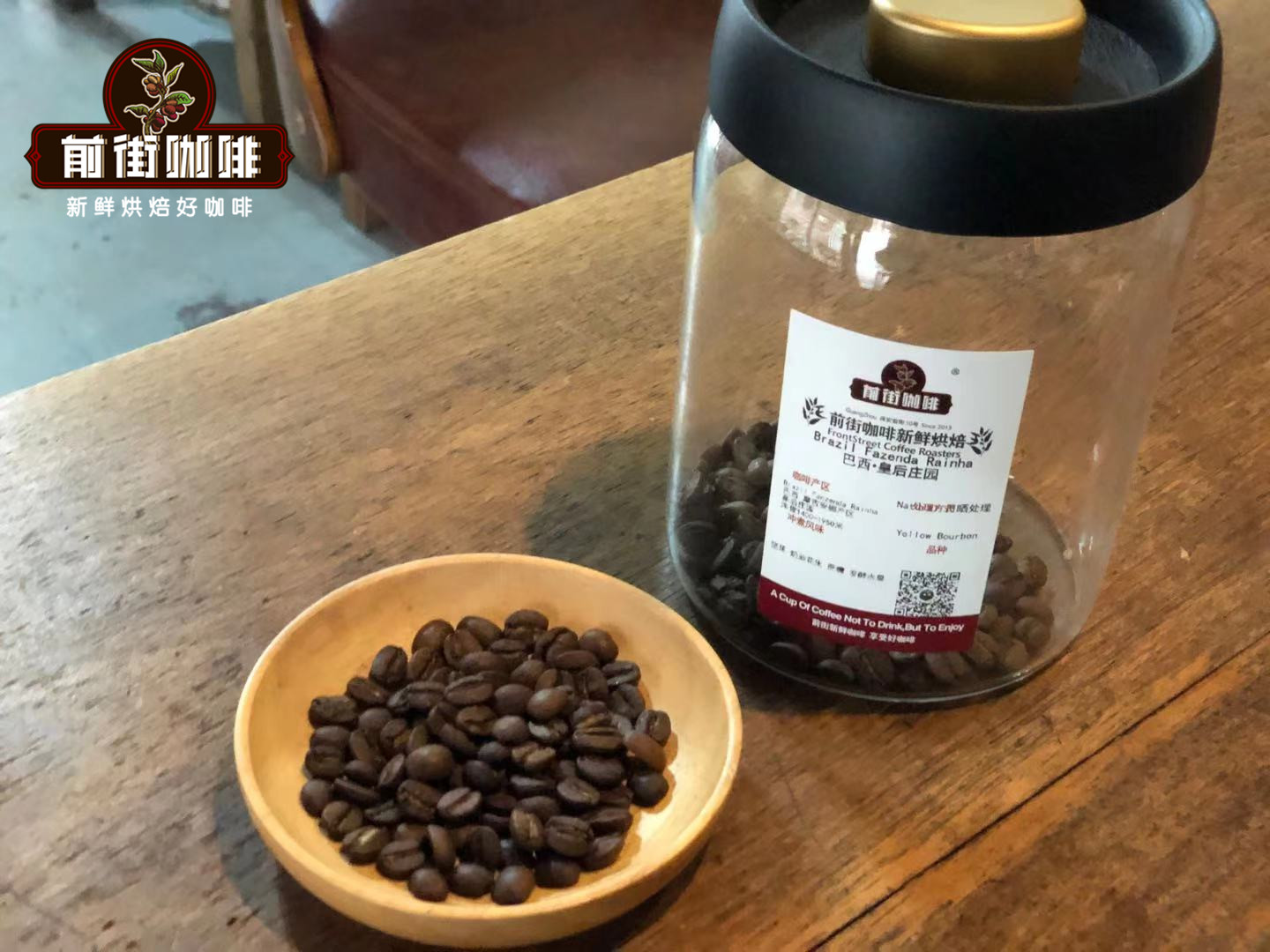
Brazil is the world's largest coffee producer and the world's second largest coffee consumer (the first is the United States). Although Brazil faces several times more natural disasters than other regions, it has enough acreage to make up for it.
Compared with other Latin American countries, Brazil has a significantly low altitude, lack of microclimate, and is used to planting coffee trees without shade trees, which leads to a slightly insipid flavor of Brazilian coffee beans. There is even a saying in the coffee industry that Brazil does not have good beans (which is also related to the fact that Brazilian coffee did not pay attention to the quality of coffee beans in the past).
However, Brazil still takes great pains to improve the quality of coffee, constantly cultivating and improving Arabica varieties, and changing the coffee bean treatment method according to the dry and wet conditions of the climate to show the best regional flavor. Commonly used treatment methods are sun, half-sun, water washing, generally high humidity producing areas will use water washing, low humidity producing areas will use sun or half-sun.
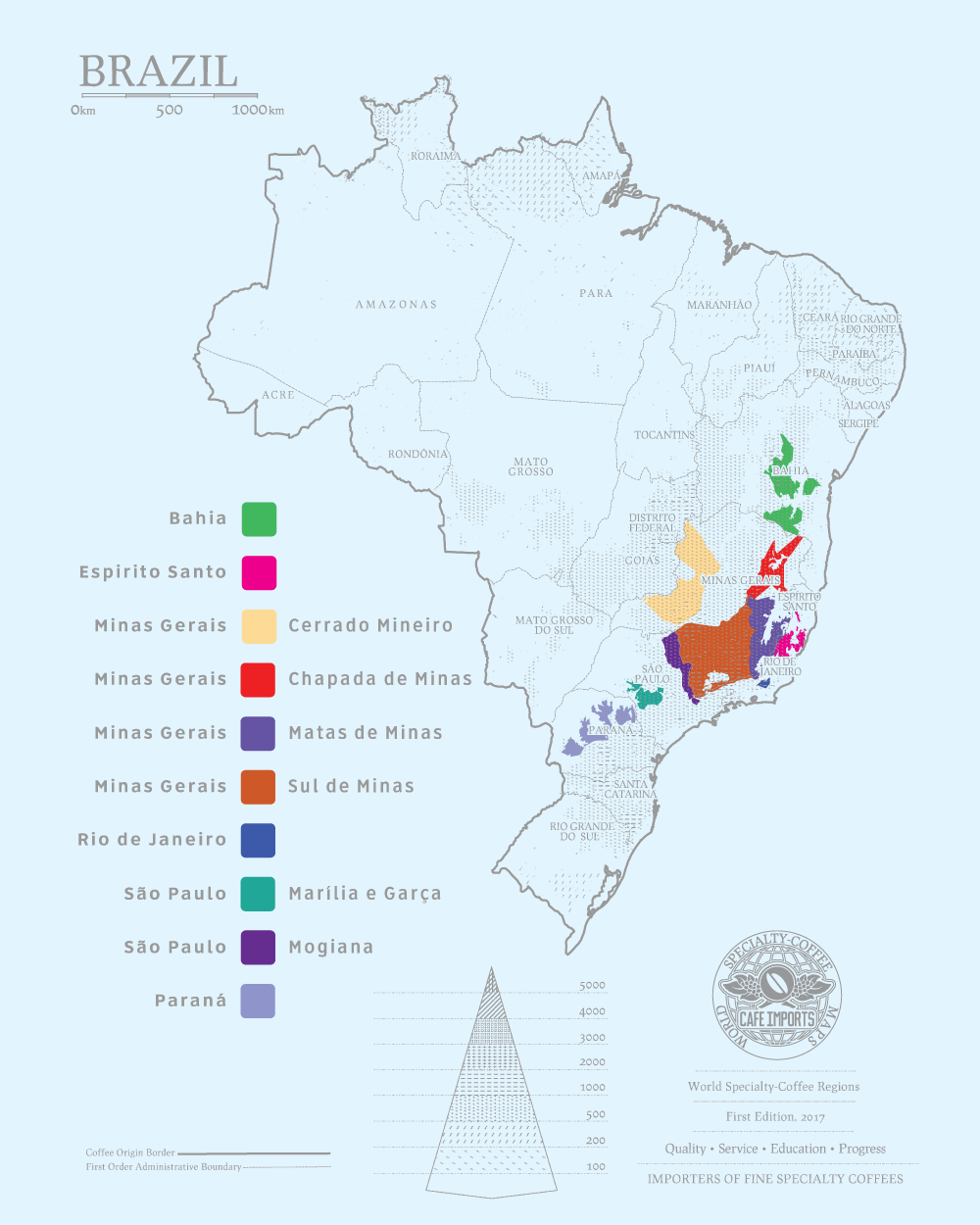
[Brazilian producing areas]
Brazil has 21 states and 17 states produce coffee, but seven of them produce the most, accounting for 98% of the country's total output. They are: Sao Paulo, Parana, Bahia, Esp í rito Santo, Minas Gerais, Rondo and Rio de Janeiro. The main producing areas of Brazil are Minas Gerais, Sao Paulo, Bahia and Esp í rito Santo, which account for 90% of the country's exports.
10. Yunnan Qianjie, the top ten coffee beans, 2013
Producing area
Baoshan, China
Altitude
1200m
Variety
Iron pickup
Treatment method
Water washing
Baking degree
Medium baking
Flavor description: sour notes of plum and citrus and nutty flavors, sweet melon and brown sugar, with a hint of black tea in the finish.
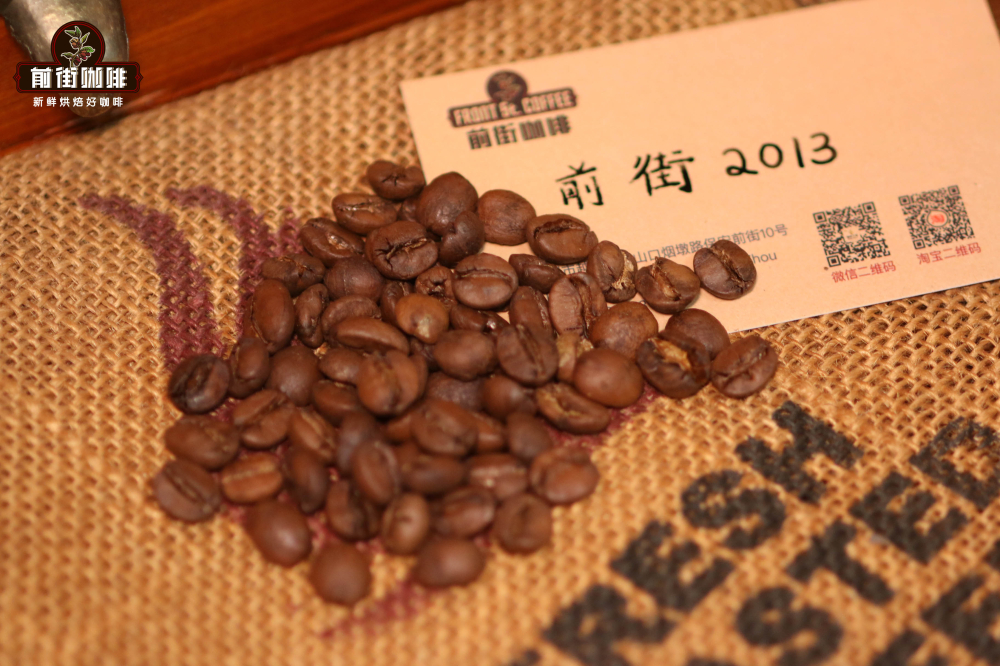
Coffee growing areas in China are mainly distributed in Yunnan, Hainan and Taiwan. Hainan mainly grows robusta coffee beans, while Yunnan and Taiwan mainly grow Arabica coffee beans. At present, Yunnan is the most popular coffee producing area in China.
Yunnan is located in the south of the Tropic of Cancer, belongs to the subtropical mountain climate region, the unique plateau red soil, the soil is fertile and loose, the climate is mild, especially suitable for growing small-grain coffee. Small seed is what we call Arabica coffee beans. when it was introduced into China, in order to promote memory, we chose the name small seed instead. The representative coffee bean in Yunnan is Katim coffee bean.
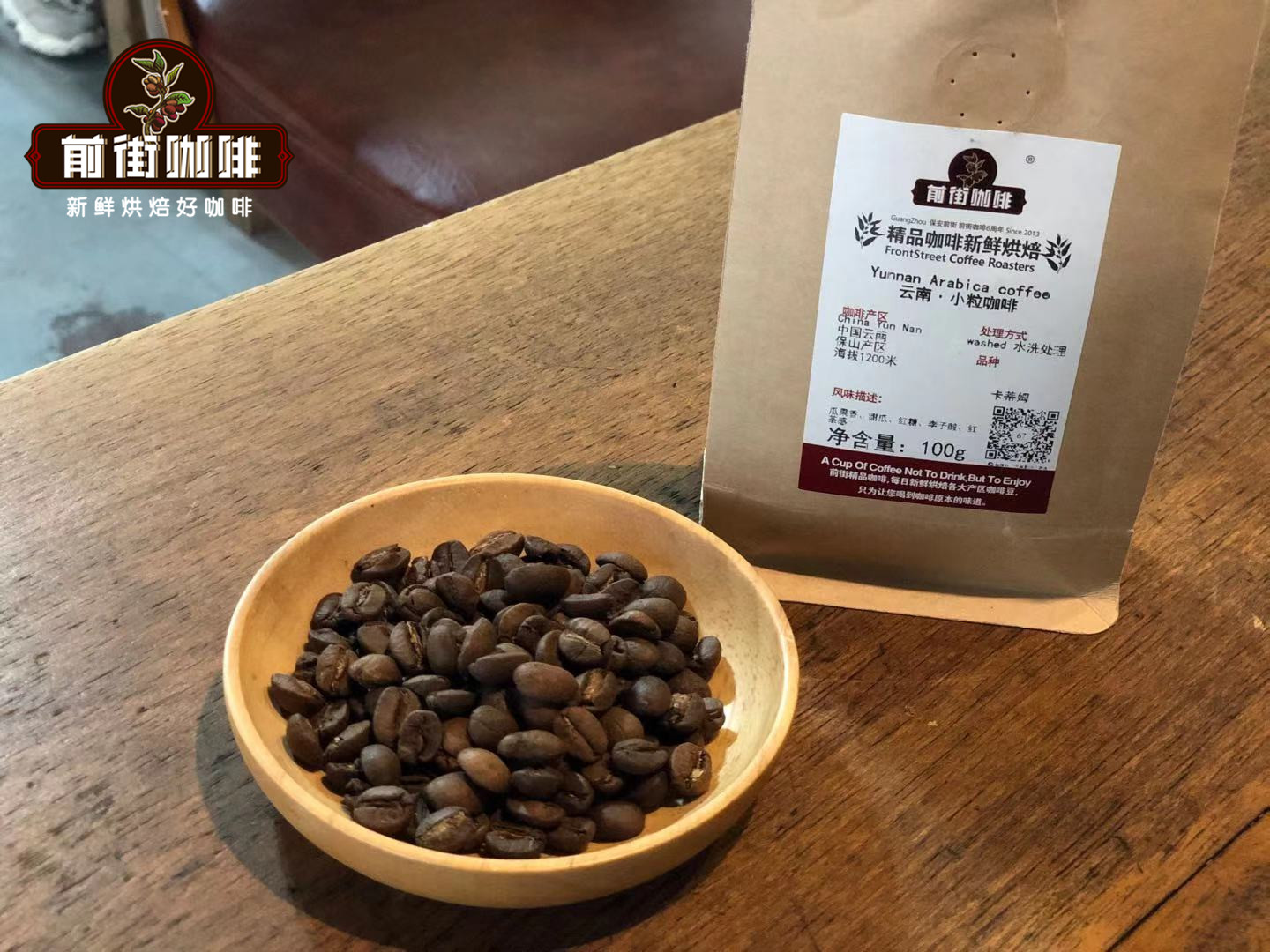
"Qianjie 2013" is the iron pickup coffee beans planted in Qianjie in Lincang, Yunnan Province, from site selection, breeding, composting and management. In 2013, Qianjie began to involve coffee cultivation, and the first batch of about 200kg coffee beans was produced in 2020, so it was named "Qianjie 2013".
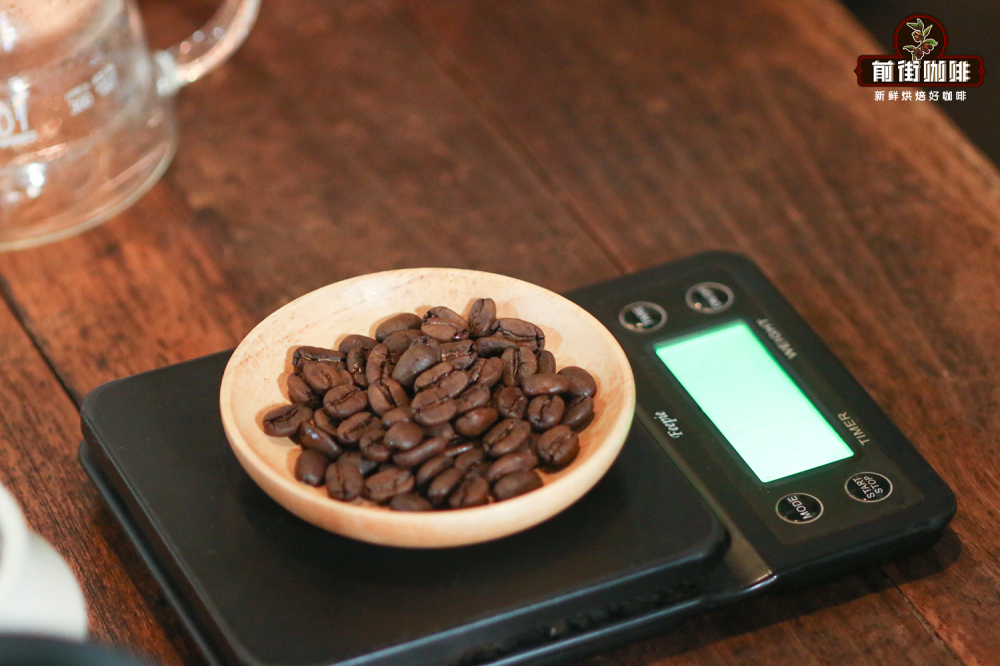
The above coffee brands are ranked in no particular order. If you like sour coffee brands, you can choose Ethiopian, Kenyan and Panamanian coffee beans. If you like mellow coffee, you can choose coffee beans from Jamaica, Brazil, Indonesia and Yunnan. If you like special aroma, you can choose Rose Valley in Colombia and Mozart in Costa Rica.
Professional coffee knowledge exchange more coffee bean information please follow the coffee workshop (Wechat official account cafe_style) more boutique coffee beans please add private Wechat Qianjie coffee, WeChat: kaixinguoguo0925
Important Notice :
前街咖啡 FrontStreet Coffee has moved to new addredd:
FrontStreet Coffee Address: 315,Donghua East Road,GuangZhou
Tel:020 38364473
- Prev

What brand of coffee beans tastes good? Coffee bean variety introduction Coffee bean brand recommendation
Professional coffee knowledge exchange more coffee bean information please follow the coffee workshop (Wechat official account cafe_style) recommended the first grade coffee beans are the blue mountain coffee beans of Jamaica. Blue Mountain Coffee beans win with popular taste and stable quality. Blue Mountain Coffee has a rich and mellow taste, and its flavor, flavor, concentration, acidity and spiciness are all even. it is widely recognized as the best coffee in the world.
- Next

Starbucks is not on the list of the world's six largest brands of coffee beans. What is the best brand of coffee beans?
Professional coffee knowledge exchange more coffee bean information please follow the coffee workshop (Wechat official account cafe_style) the world's six major brands of coffee beans Starbucks is not on the list what brand of coffee is good illy: Italy's national treasure coffee, using 100% Arabica beans to produce a unique aroma, and delicate and silky rich taste unforgettable. Lavazza: No. 1 in Italian sales
Related
- Guji coffee producing area of Guji, Ethiopia: Humbela, Shakiso, Wulaga
- What is the most expensive variety of Qiloso in BOP multi-variety group?
- How to store the coffee beans bought home?
- Why are Yemeni coffee beans so rare now?
- Ethiopian Sidamo all Red Fruit Sun Sun Santa Vini Coffee beans
- SOE is mostly sour? What does it mean? Is it a single bean? what's the difference between it and Italian blending?
- Is Italian coffee beans suitable for making hand-brewed coffee?
- How to choose coffee beans when making cold coffee? What kind of coffee beans are suitable for making cold coffee?
- Just entered the pit to make coffee, what kind of coffee beans should be chosen?
- Can only Japan buy real Blue Mountain Coffee? What are authentic Jamaican Blue Mountain coffee beans?

